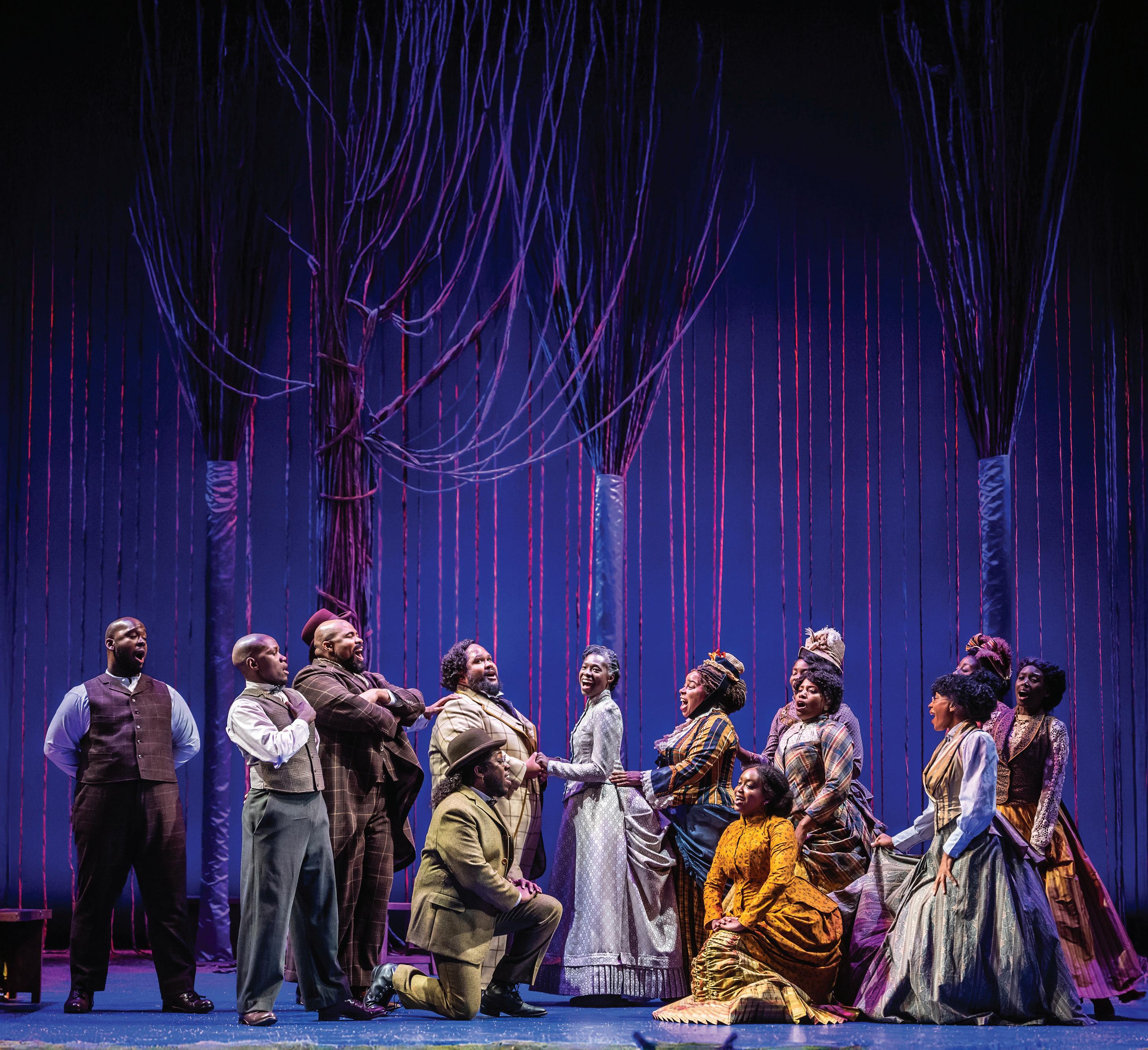Electronic monitoring: what’s next?
by Shawn Mulcahy, p. 8
David Cerda & Hell in a Handbag
by Kerry Reid, p. 16

A look at ve local clubs by Shira Friedman-Parks, p. 12

Electronic monitoring: what’s next?
by Shawn Mulcahy, p. 8
David Cerda & Hell in a Handbag
by Kerry Reid, p. 16

A look at ve local clubs by Shira Friedman-Parks, p. 12
03 Reader Letters
03 Editor’s note Besties
04 The To-Do Lady Bunny, National Public Housing Museum, and more
06 Feature | Sula Las Flores rises from the ashes.
08 Feature | Mulcahy What’s next for electronic monitoring in Cook County?
10 Labor Pains | Brown Dispensary 33 becomes worker-owned, Pritzker vetoes protections for warehouse workers, Tony’s Fresh Market votes against unionizing, and more
11 Make It Make Sense | Mulcahy State’s attorney expands felony review bypass, Quezada confirmed to City Council, and more
12 Cover Story | Friedman-Parks Mail art clubs are rooted in an affection for the tangible.
15 Art of Note A rare look at Betye Saar’s early inspirations and a rich interweaving of contemporary Indigenous art at the Block Museum
16 Stages of Survival | Reid Hell in a Handbag’s David Cerda unpacks his personal baggage in Scary Town
18 Plays of Note Steppenwolf’s blistering The Book of Grace by Suzan-Lori Parks and Rivendell’s world premiere of Lisa Dillman’s No Such Thing FILM
19 Feature The Chicago film industry is working toward sustainability.
20 Moviegoer From meditative to madcap
21 Movies of Note A Minecra Movie digs itself a hole so deep in references, chaotic plotting, and forced humor that not even a diamond pickax could save it; Việt and Nam is a dreamy and meditative exploration of loss, grief, and the lingering remnants of war.
22 Feature | Brown Pictoria Vark starts a new chapter with an album about endings.
24 Shows of Note Previews of concerts including Black Ends, Josephine Foster, and Sons of Ra
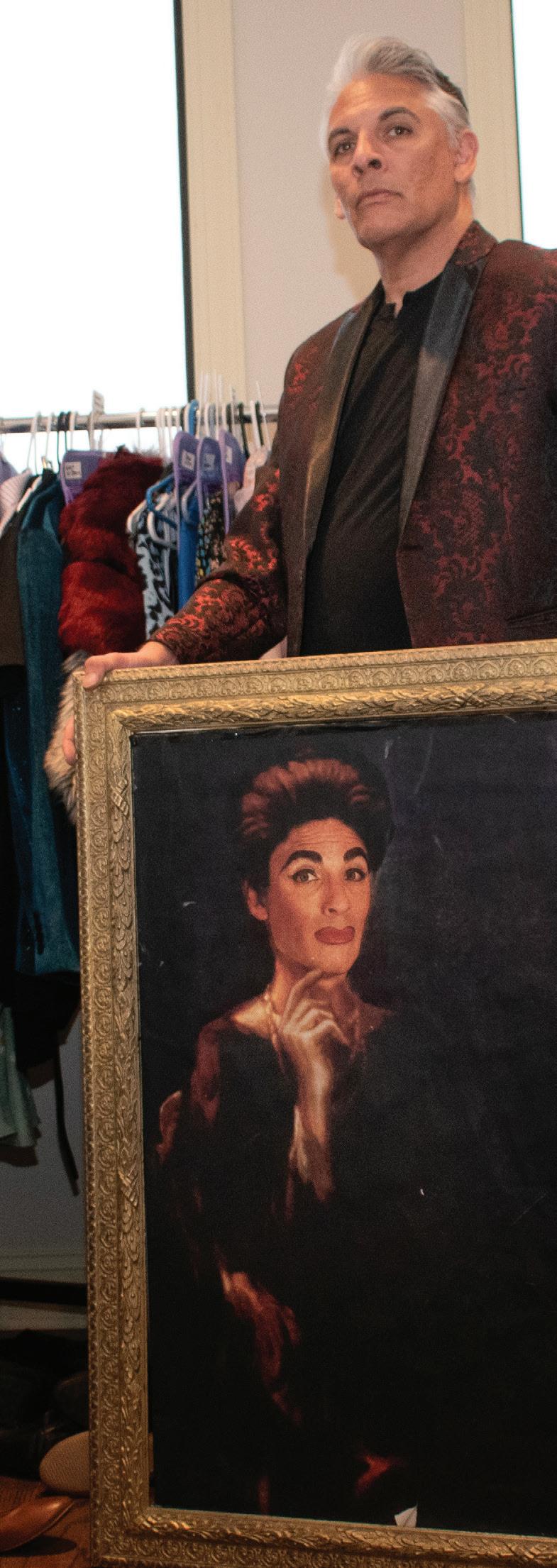


TO CONTACT ANY READER EMPLOYEE, EMAIL: (FIRST INITIAL)(LAST NAME) @CHICAGOREADER.COM
PUBLISHER AMBER NETTLES
CHIEF OF STAFF ELLEN KAULIG
EDITOR IN CHIEF SALEM COLLO-JULIN
ASSISTANT MANAGING EDITOR
SAVANNAH RAY HUGUELEY
PRODUCTION MANAGER AND STAFF
PHOTOGRAPHER KIRK WILLIAMSON
SENIOR GRAPHIC DESIGNER AMBER HUFF
GRAPHIC DESIGNER AND PHOTO RESEARCHER SHIRA FRIEDMAN-PARKS
THEATER AND DANCE EDITOR KERRY REID
MUSIC EDITOR PHILIP MONTORO
CULTURE EDITOR: FILM, MEDIA, FOOD AND DRINK TARYN MCFADDEN
CULTURE EDITOR: ART, ARCHITECTURE, BOOKS KERRY CARDOZA
NEWS EDITOR SHAWN MULCAHY
PROJECTS EDITOR JAMIE LUDWIG
DIGITAL EDITOR TYRA NICOLE TRICHE
SENIOR WRITERS LEOR GALIL, DEANNA ISAACS, BEN JORAVSKY, MIKE SULA
FEATURES WRITER KATIE PROUT
SOCIAL JUSTICE REPORTER DEVYN-MARSHALL BROWN (DMB)
STAFF WRITER MICCO CAPORALE
MULTIMEDIA CONTENT PRODUCER SHAWNEE DAY
SOCIAL MEDIA ENGAGEMENT
ASSOCIATE CHARLI RENKEN
VICE PRESIDENT OF PEOPLE AND CULTURE ALIA GRAHAM
DEVELOPMENT MANAGER JOEY MANDEVILLE
DATA ASSOCIATE TATIANA PEREZ
MARKETING ASSOCIATE MAJA STACHNIK
MARKETING ASSOCIATE MICHAEL THOMPSON
VICE PRESIDENT OF SALES AMY MATHENY
SALES REPRESENTATIVE WILL ROGERS
SALES REPRESENTATIVE KELLY BRAUN
MEDIA SALES ASSOCIATE JILLIAN MUELLER
ADVERTISING
ADS@CHICAGOREADER.COM, 312-392-2970
CREATE A CLASSIFIED: CLASSIFIEDS.CHICAGOREADER.COM
DISTRIBUTION CONCERNS
DISTRIBUTIONISSUES@CHICAGOREADER.COM
READER INSTITUTE FOR COMMUNITY
JOURNALISM, INC.
CHAIRPERSON EILEEN RHODES
TREASURER TIMO MARTINEZ
SECRETARY TORRENCE GARDNER
DIRECTORS MONIQUE BRINKMAN-HILL, JULIETTE BUFORD, DANIEL DEVER, MATT DOUBLEDAY, JAKE MIKVA, ROBERT REITER, MARILYNN RUBIO, CHRISTINA CRAWFORD STEED
READER (ISSN 1096-6919) IS PUBLISHED WEEKLY BY THE READER INSTITUTE FOR COMMUNITY JOURNALISM 2930 S. MICHIGAN, SUITE 102 CHICAGO, IL 60616, 312-3922934, CHICAGOREADER.COM
COPYRIGHT © 2025 CHICAGO READER
AND
Re: “The ghosts of Geneva’s ‘home for wayward girls,’” written by Katie Prout and published in our March 27 issue (volume 54, number 25)
What a gripping historical exposé. I’m speechless. —Angela Lampsbury, via Instagram
This was a good, intriguing, and relevant story. A good example of worthy journalism. I hope tons of people read it. —Elke Claus, via Instagram
Re: “Best neighborhood talent show,’” written by Jack Riedy for our Best of Chicago Music & Nightlife section and published in our March 6 issue (volume 54, number 22)
Thank you Chicago Reader for featuring Welcome to the Show in the annual Best of Chicago issue! The Reader was my guide to the amazing Chicago arts scene when I moved here in 2005. I always
loved the Best Of issue and would search it excitedly, taking notes on everything that sounded cool. It’s really something to think that others could discover my show in that same fashion. —Derek Bish, via Instagram
Find us on socials: Facebook and Bluesky: chicagoreader X: Chicago_Reader
Instagram and Threads: chicago_reader
LinkedIn: chicago-reader
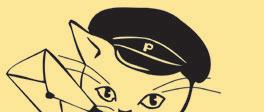
The Chicago Reader accepts comments and letters to the editor of less than 400 words for publication consideration. m letters@chicagoreader.com


ast year around this time we were standing in the middle of Lincoln Park Zoo with some of you, watching two of the female lions remind us that they’re actual wild animals by grabbing two ducks from the air and chowed down on them, right there in the lion enclosure. It was the Best of Chicago’s Animal Kingdom, a fitting if unscripted moment for our Best of Chicago party that night. We celebrated with our readers, our sta , board members, community vendors, and, most important, the winners and finalists for a fun- and frolic-filled evening in the middle of the city.
Last Wednesday night, because of the generosity of the 8 Hospitality group and their venue Joy District, we were able to have a smaller party that was just as fun. Due to capacity, we were only able to host our Best of Chicago top winners this time around. But the vibe was great: no chomping lions, but plenty of community-minded and curious people learning about one another’s businesses, artistic practices, and the state of our collective Chicago a airs.
The reader voting for Best of Chicago isn’t

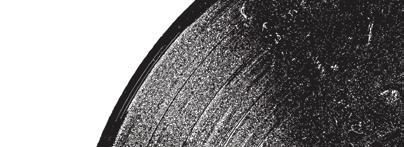



something that I have any influence over. We ask you to make nominations, you deliver, and we on the editorial side of the paper get a sense of what’s important to some of you as the voting period flies by. And when we make the Best Of issue, we try to throw in some curves, point out less-popular picks, and make sure you’re aware of our version of Chicago.
Wednesday was a chance for me to compare notes with some of you, and I was excited to fi nd that you’re not just in it for the glory— you’re actually reading us. I was happy to meet so many of our winners and hear that you’re also our longtime readers: You chatted with me about everything from our movie reviews to our news stories, and you took our pleas seriously to “Tell your friends to donate if you want to read more.” I always tell people that Chicagoans are the best people in the world, and it’s great to be proved right. Feels like grabbing a prize out of the sky. v
—Salem Collo-Julin, editor in chief m scollojulin@chicagoreader.com


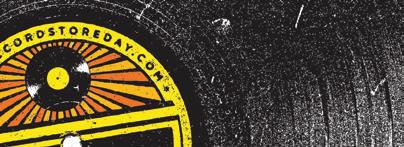
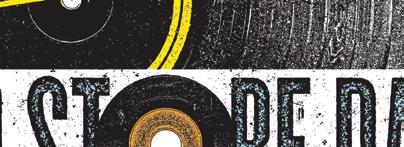
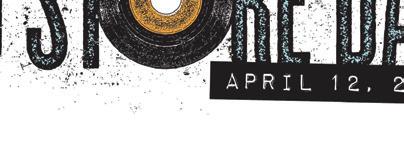


By SALEM COLLO-JULIN
Sun 4/13
Three at the market: Hyde Park Handmade (organized by Reader alum Vera Videnovich) returns to the Promontory and concentrates on south-side craft, fashion, and food vendors. DJ Sean Alvarez provides soul and other sounds for smooth shopping.
There’s plenty to do in Chicagoland for April. Here are some suggestions!
THU 4/10
It’s the time of year for birds to start gathering nesting materials and squirrels popping out of their tree hideaways. Tonight, a bunny will show up in Schaumburg, but be wary of getting too close—this one definitely has a bite. Legendary drag performer Lady Bunny brings her acerbic humor and groan-inducing gags that “go there” to Chicago Improv at the Woodfield Mall this evening, and the show title says it all: Don’t Bring the Kids!
7 PM, 5 Woodfield Mall, Store K120B, Schaumburg, $35 ($50 VIP for premium seating) plus two-item minimum food or drink purchase required, 21+, improv.com/chicago
FRI 4/11
The National Public Housing Museum opened last week, and its existence is unique amongst institutions that have received federal capacity-building funding. The main building used to be one of the Jane Addams buildings in the Chicago Housing Authority’s near-west-side ABLA Homes development, and the museum’s origins can be traced back to the residents’ desires. Community leader Deverra Beverly and others began campaigning for a memorialization of the presence of public housing in Chicago soon after the city and the CHA started to demolish units in the 90s; the museum, which includes installations of restored public housing apartments and an archive of oral histories culled from former residents, is a fitting celebration of community.
PM, general entry is free but special exhibits including apartment tours are $25, $15 students, seniors, and children, 919 S. Ada, nphm.org
SAT 4/12
Yoga, stretching, and other movement work can open up the mind–body connection (and let loose other kinds of passages, as anyone who’s been in a crowded hot yoga studio has smelled), but some of us can get distracted by the soothing, new age music that tends to accompany the meditative art. Thankfully, there are options: today’s Doom Movement Yoga session promises 60 minutes of Hatha and Vinyasa style flows set to a soundtrack of “rhythmic doom metal” sure to soothe the hesher within.
maker markets for those interested in doing some spring sprucing up! Today, the Empty Bottle hosts Handmade Market Chicago , featuring over 30 local handmade artists and their wares. It’s free to browse, the bar will be open, and Pizza Friendly Pizza will be open for brunch next door.
Noon–4 PM, 1035 N. Western, free to browse, handmadechicago.com
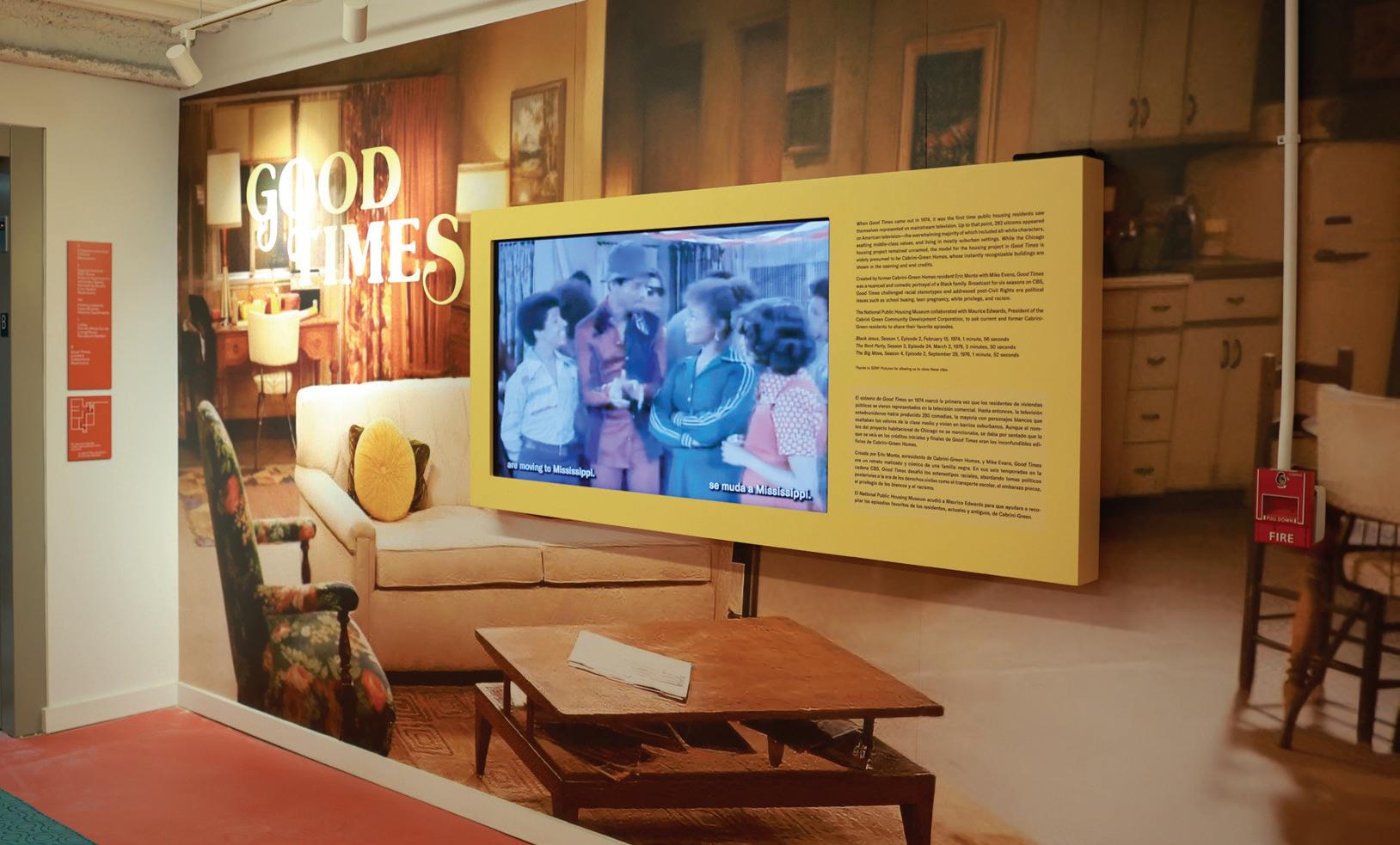
11 AM–3 PM, 5311 S. Lake Park West, free to browse, all ages, instagram.com/ hydeparkbazaar
The Ramova Theatre hosts a monthly Community Market featuring local artists, makers, and farmers selling their wares in the lobby and beer garden. Kids’ activities are planned, and shoppers with friendly dogs are welcome to hang out with them in the outdoor market area (service animals welcome everywhere).
11 AM–4 PM, 3520 S. Halsted, free to browse, all ages, ramovachicago.com
On the north side, Schubas hosts their fourth annual Schubas Garage Sale this afternoon, which o ers an array of vintage and upcycled clothing vendors this year, as well as home decor and possibly extra treasures from the music venue. DJs from CHIRP Radio will be spinning.
Noon–4 PM, 3159 N. Southport, free to browse, all ages, lh-st.com
Wed 4/16
12:30 PM (doors 12:15 PM), Gman Tavern, 3740 N. Clark, $20 (includes a Toke THC seltzer), 21+, gmantavern.com
This weekend is full of local vendor and
The massive and overwhelming Chicago Comic and Entertainment Expo (C2E2) brings all the cosplayers to our front yard this weekend (specifically, McCormick Place on Friday, Saturday, and Sunday). This means that public sightings of people in costumes will be up in the evenings. Bassline in the South Loop is celebrating with Multiverse of Afters, an “uno cial after rave” hosted by Collective Media and EDM Chicago. Cosplayers and costumes are encouraged.
9 PM–3 AM, 2239 S. Michigan, $20–$30, 21+, wamitickets.com/events/735
Curator Giovanni Aloi worked with the Driehaus Museum to invite contemporary artists to select a part of the museum’s collection, study the item’s history, and respond with sitespecific installations. The resulting exhibition, “A Tale of Today: Materialities,” features work from 14 artists and art groups that investigate both the culture of the institution and the actual materials that make up its building. It’s on view through Sunday, April 27.
Wed 11 AM–7 PM, Thu–Sun 11 AM–5 PM, 50 E. Erie, $20, $10-$15 students and seniors, free for children 12 and under and active military, free for all on Wednesday evenings from 4–7 PM, driehausmuseum.org v
m scollojulin@chicagoreader.com
for TOURING CHICAGO’S LAKEFRONT WITH GEOFFREY BAER is provided by:
Lead Sponsor: The

Lead

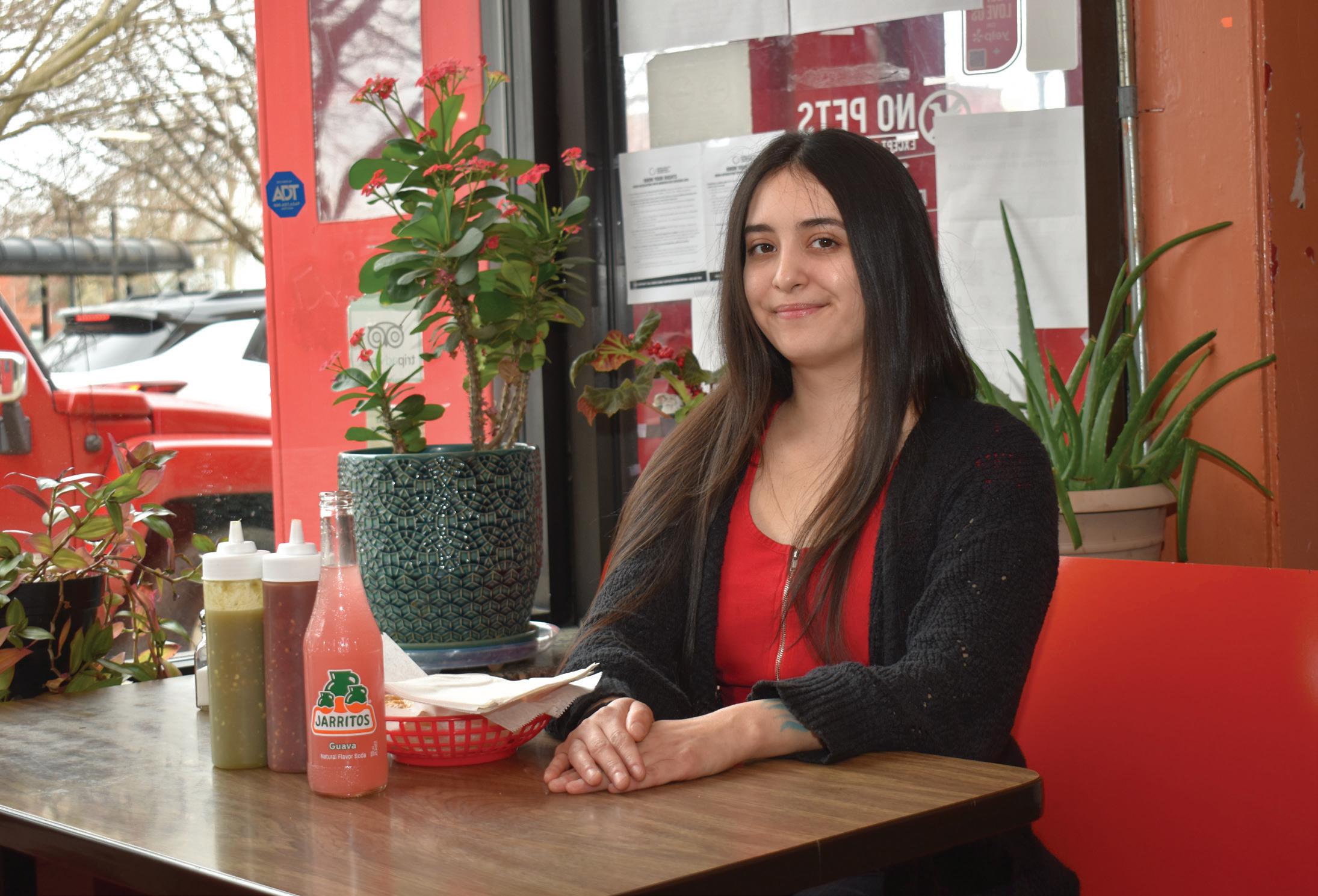
Jazmin Flores at Taqueria el Asadero, her dad’s North Center restaurant KIRK WILLIAMSON FEATURE
Jazmin Flores’s reborn taqueria comes to the next Monday Night Foodball, the Reader’s weekly chef pop-up at Frank and Mary’s Tavern.
By MIKE SULA
Jazmin Flores was born of taco royalty, but the king didn’t always make it easy.
“My dad would have us clean tables,” she says. “We gave out food, washed dishes. He would have us remove the stems from the jalapeños. He’d be like, ‘Be careful. Don’t touch your face. Wash your hands.’ Now, when I see the employees do it, they have gloves. I’m like, man, I remember doing that with my little bare hands.”
But the cause was noble. Flores and her siblings grew up in North Center’s Taqueria el Asadero, which their father Efrain opened in 1993 across from Welles Park.
Over decades, word of mouth about his commitment to seared- and chopped-to-order skirt steak tacos and burritos distinguished him as the veritable carne asada king of Chicago. A perennial on best-of lists, Taqueria el Asadero peaked in renown after a visit from Anthony Bourdain for an episode of The Layover, featuring a brief clip of a tatted-up adult Jazmin at the register.
She told me the jalapeño story at one of the restaurant’s red Formica tables, with a copy of Mastering the Art of French Cooking between us. She’d borrowed it from nearby Sulzer Library, where she actually spent most of her
before returning to the family business and then opening her own spot, Taqueria las Flores, in Albany Park in 2018. It was both a return to what she knew and an assertion of independence.
“Growing up in Taqueria el Asadero was awesome but di cult at the same time,” she says. “When you’re raised by immigrants, there’s a complicated navigation in finding your identity. I wanted something different. I wanted to be out of my dad’s shadow. I told him, ‘I want to get to the point where people stop asking me about you and ask about me.’”
She got there with a menu rooted in Taqueria 101, but with frequent specials that nodded toward prevailing trends or holidays, like kimchi– carne asada tacos, Flamin’ Hot Cheetos quesadillas, or matcha-spiked green horchata for Saint Patrick’s Day.
She also hosted Spanish-language story times for toddlers, held fundraisers for the neighboring elementary school, and wrote a weekly newsletter for a network of neighborhood regulars that helped her weather robberies, COVID, sta shortages, and inflation.
“It was mine,” she says. “It was me.”
Then, in August 2023, she answered an early morning call from her opening cook, who said the dining room was filling with smoke. She rushed to the restaurant where an electrical fire had sparked in a storage room. By the time the fire department arrived, it was all over.
“I got so depressed, so depressed. But I’ve been told that I haven’t stopped after the fire. I was trying to find ways to keep my brand. I’ve just been a motor, like the little Energizer Bunny.”
Ten days after the fire, on her birthday, she held her first pop-up, a fundraiser at Honey Butter Fried Chicken, whose chef, Josh Kulp, was an Asadero regular and family friend.
time as a kid. “My dad gave me two choices— either I worked or I would go to the library, read a book, and report back to him what I read.”
Flores loved growing up in the restaurant, which housed a Terminator pinball machine and a Deer Hunter video game. The siblings bonded with the kids from the Thai spot next door. “I got to play and work,” she says. “I got to grow here. I got to know people, and they got to know me.”
Neither she nor her parents expected her to pursue a restaurant career. After studying mortuary science, she spent a few years as an apprentice funeral director and embalmer
She served fried chicken tacos made with the restaurant’s tenders, a collaborative special she once ran at the taqueria, with rice, jicama slaw, pico de gallo, and a creamy jalapeño cream sauce.
Other chefs stepped up to help, too. She popped up a month later at Taqueria Chingón
“When you’re raised by immigrants, there’s a complicated navigation in finding your identity. I wanted something different.”

“I didn’t know anybody from the pop-up community. It wasn’t until I lost a restaurant and I sought help that I became friends with a lot of them.”

with a hibiscus flower quesadilla with pomegranate, pea shoots, Oaxaca and cotija cheeses, and salsa macha on the restaurant’s blue corn tortillas.
The pop-up community, in particular, turned out to support her. She became a prolific collaborator with Juan Meza of Johnny’s Table and other chefs with established roaming concepts, such as Birria Ta-Ta-Tacos! and Smash Jibarito.
“I didn’t know anybody from the pop-up community,” she says. “It wasn’t until I lost a restaurant and I sought help that I became friends with a lot of them. It opened the door for me to meet new people and new opportunities. There were times where I had my own pop-ups, and I had Juan or the rest of the guys to help me. And then I would help them.”
She also started helping her dad again, which brought her back into the orbit of the library. She’s been experimenting with French, Chinese, and Thai cooking at home but still isn’t sure she wants Taqueria las Flores to come back as a brick-and-mortar.
“I don’t know, I’m kind of traumatized,” she says. “I feel that I should be over this, but my therapist is like, ‘Bro, this was a huge thing. Take your time.’ So we’ll see about the future.”
In the short term, las Flores is popping up at Monday Night Foodball, the Reader’s weekly chef pop-up at Frank and Mary’s Tavern. Juan Meza will be in the house helping out, and Flores is o ering a reprise of her Honey Butter Fried Chicken collaborative taco. She’ll announce the rest of her menu next week. It starts at 5 PM on Monday, April 21, at 2905 N. Elston in Avondale. But first, don’t miss the return of Jeremy Leven’s Basque tavern Gilda this Monday, April 14—and check out the rest of the spring Foodball lineup at chicagoreader. com/food/monday-night-foodball. v m msula@chicagoreader.com




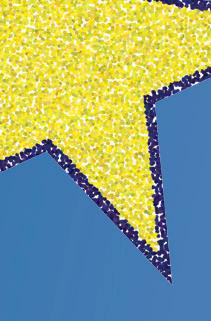



























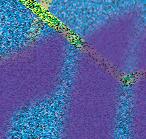









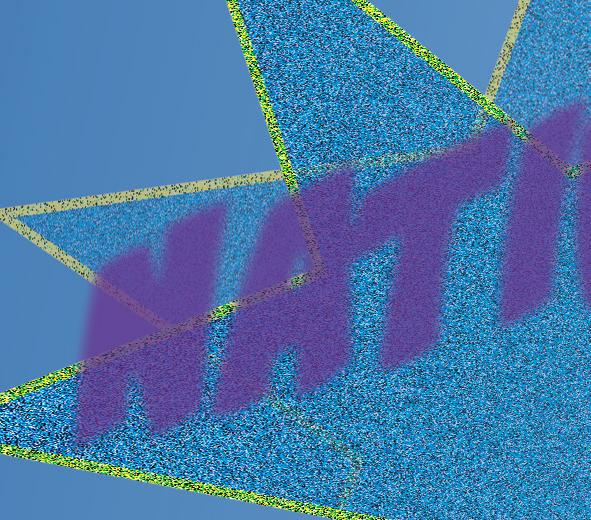




















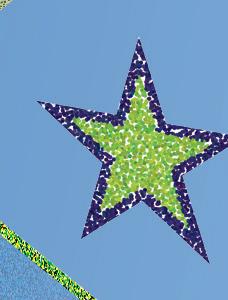








On April 1, Cook County began a long-discussed process to consolidate parallel electronic monitoring programs under the Office of the Chief Judge.
By SHAWN MULCAHY
Lavette Mayes had already spent 425 days locked up in the Cook County jail when she found herself in front of a judge in 2016. The Chicago Community Bond Fund had just helped her buy her freedom, and the judge was prepared to let her go home through a program known as home confinement. Mayes didn’t fully understand what it entailed, but it sounded far better than jail.
The 55-year-old single mother of two quickly discovered, however, that the electronic tracking device shackled to her ankle came with its own set of debilitating consequences. Mayes was to remain at home 24 hours a day unless she received prior approval from the Cook County Sheriff’s Office, which, until recently, has been charged with surveilling people on pretrial electronic monitoring (EM). She describes the process as painstaking and often futile. She couldn’t take her kids to school, shop for groceries, or even use the washing machine in her apartment building’s basement.
“It was so stressful. It was so entirely stressful being on electronic monitoring,” Mayes tells me. “I think electronic monitoring was worse than a jail sentence.” She lived in constant fear of breaking one of the numerous rules set by the sheri ’s o ce and being hauled back to jail. “You lock them up at home and all you’re doing is putting little jails in the community,” she says.
The Cook County Sheri ’s O ce launched its EM program in 1989 under a federal judge’s order to reduce a dangerously overcrowded jail. For the next 35 years, it remained one of the largest, most restrictive uses of the technology in the country. But on April 1, the sheri ’s o ce began the process of shuttering
“I think electronic monitoring was worse than a jail sentence.”
its EM division, with plans to complete the closure later this fall.
Instead, people ordered to wear a monitor until their case goes to trial will now be supervised by sta under the o ce of Cook County’s chief judge, Timothy Evans, which has run its own EM program for people serving probation since 2011.
Advocates and people impacted by the legal system have long highlighted fundamental issues with the county’s use of EM, pointing to the cruelty of 24-hour home confinement and the ine ciency of two programs overseen by two separate o ces.
One of the main recommendations from a 2022 study commissioned by the county’s Justice Advisory Council was to consolidate electronic monitoring under one pretrial services o ce. Researchers from the two organizations selected to complete the report, CGL Companies and the Chicago Appleseed Center for Fair Courts, concluded that the development of parallel electronic monitoring programs “impairs coordination of pretrial release programs and increases costs, without providing discernible benefits to the County.”
Evans’s o ce declined multiple interview requests. In an emailed statement, the chief judge called EM a “middle ground between being detained in jail pretrial and being released with no conditions.” He continued, “Electronic monitoring can be more humane than full pretrial detention and seeks to recognize the accused’s presumption of innocence. However, its conditions still impose signifi cant restrictions on the liberty of the accused while also not providing the same level of protection for public safety that detention might.”
Cathryn Crawford, a longtime public defense attorney, thinks the move is a step in the right direction. But, she says, ultimately the county needs to reduce reliance on a technology that has devastating repercussions for people on EM and their families. “It’s just this constant panic of being terrified that you’re going to be taken into custody,” Crawford tells
me. “And it didn’t advance public safety. What it did do is advance people pleading guilty when they shouldn’t necessarily plead guilty.”
That’s exactly what happened to Mayes. After 145 days on EM, she decided she couldn’t take it any longer and accepted a plea deal. “Every time I went to court for my court case, it would be a lot of crying and sobbing and not really knowing what’s going to happen with me,” she says. “So, I decided that I would just take a plea because I didn’t want to put my family through any more of that.” It was a devastating choice, Mayes tells me, because she thought she had a great shot at actually beating her case. But, she says, “they keep you on pins and needles all the time. I just couldn’t see myself putting them through a whole ’nother year of that.”
One of the biggest questions concerning the two programs’ consolidation is how judges will assign people released pretrial to EM. Historically, the sheri ’s EM program has been reserved for people considered “high risk,” like those facing murder or weapons charges. People under the sheri ’s watch are confined to their homes 24 hours a day and can be taken back into custody at any time for alleged violations.
The chief judge’s program, meanwhile, has typically been used for people on probation—a period of court-ordered supervision served in lieu of incarceration. People monitored under Evans’s program are usually given a 12-hour curfew between 7 PM and 7 AM but are otherwise free to come and go as they like, allowing them to continue school, work, and childcare duties. Each person is also paired with a pretrial services o cer who functions similar to a case manager, ensuring people on probation follow the conditions of their supervision and show up to court.
“The sheri ’s program operated without an individual o cer assigned to each case, which meant that participants were at the mercy of a very complicated call center approach and also very strict rules that the only way to get
movement was to essentially get a judge’s order, which is often simply impractical,” says Sarah Staudt, one of the main authors of the 2022 CGL and Chicago Appleseed Study. Researchers recommended consolidating EM under the chief judge’s office, she says, because of “the ine ciency of having two programs” and “because of the harshness of the sheri ’s program and the number of violations that were coming in.”
Jordan Boulger, an assistant in Cook County’s Adult Probation Department, told

the county Board of Commissioners in early March that Evans’s o ce plans to expand its current setup, matching each person assigned to EM to a pretrial services o cer, with a fourphase plan that runs through May 2026. “We wanted to take the opportunity presented by this shift to lean into those best practices and to focus our resources on the ‘highest risk’ individuals we supervise,” he said.
To do so, the county will need to come up with $10 million, according to Boulger. Evans’s o ce anticipates hiring an additional 153 new full-time employees to sta beefed-up home confinement and pretrial services departments, which expect to add about 900 new people to their caseloads over the next six months, bringing the total number of people on EM to about 3,200. The new sta will need equipment, like computers and walkie-talkies, and new office space to house the expanded workforce, Boulger said, adding that the
Services, which monitors people placed on EM throughout the state, but Cara Smith, the o ce’s director, told county commissioners at a March hearing that funding is contingent on the General Assembly. With a looming $3 billion budget deficit, whether state lawmakers will approve additional funding remains to be seen.
The sheri ’s o ce will continue monitoring the people under its watch until their cases wind their way through the courts, likely sometime in September, said Jason Hernan-

“The system that we have is unnecessarily punitive and isn’t working.”
Ankle monitors can use GPS or radio-frequency identifi cation. SHYCITYNIKON/FLICKR VIA CC BY-NC 2.0
unit’s current space at the Leighton Criminal Courthouse is “bursting at the seams.”
The Board of Commissioners moved $6.3 million from Cook County sheri Tom Dart’s office to Evans’s in the 2025 budget, but the remainder of the money required to get the program o the ground has yet to be allocated. The chief judge’s o ce is seeking reimbursement from the Office of Statewide Pretrial
the jail there will still be the need for additional sta ,” he says.
Naomi Johnson, Chicago Appleseed’s co-executive director, says the April 1 consolidation has been a long time coming.
“I’m definitely excited that this transition is happening, finally.”
She urges Evans and other elected o cials to reject calls for a more punitive system.
“My concern is that judges or prosecutors— or the two of them put together—will make arguments and decisions that make the O ce of the Chief Judge’s program more like how the sheriff’s program has operated in the past, but I think that really remains to be seen. I would love for that not to occur,” she says.
Johnson and other advocates who spoke with me also raised transparency concerns. Unlike most other government o ces, the judiciary in Illinois is not subject to the state’s open records law. Previously, researchers used the Freedom of Information Act to glean information about the demographics of people ordered to pretrial monitoring and the rules and procedures that governed nearly every aspect of their lives. Now, access to that information is entirely up to Evans. The chief judge’s o ce currently publishes some aggregated information about the race, gender, and age of people on EM and the charges they’re facing, but Johnson says individualized information, as well as the policies under which EM sta operate, is crucial for accountability. “I am concerned about outside advocates being able to monitor and understand what’s going on,” Johnson says. “It’s going to require some more creativity unless the O ce of the Chief Judge decides to be more forthcoming about the progress with his program.” (Evans’s office did not respond to questions about reporting and transparency.)
person to appear in court. If they miss their court date, a judge can then issue a warrant for their arrest.
“The real question,” says Crawford, the public defense attorney, “is how much the chief judge changes the way the program has been run. My hope is not very much because even though it’s still incredibly di cult for young people to be on electronic monitoring, having an identifi ed o cer to talk to, to develop a relationship with, is a much more equitable way of monitoring people.” It also a ords people time to consult with their lawyers, Crawford says, to determine whether a violation actually took place and to potentially fight false accusations from the community rather than behind bars. “The judges had a tendency, if someone was taken in, to just assume that it was a correct apprehension.” People are rarely accused of committing new crimes while on EM. An internal sheri ’s report from September 2021 found that just 3.5 percent of the entire pretrial monitoring program had been rearrested. Meanwhile, the monitors themselves generate a fl ood of false alerts every day. About eight of every ten alerts from the county’s EM vendor are false alarms, according to sheri ’s o ce data. (Evans’s o ce did not respond to questions about the inaccuracy of GPS monitors or whether they planned to reevaluate the use of the technology in the future.)
dez, the sheri ’s executive director of intergovernmental relations, at a March county board hearing. Dart spokesperson Matthew Walberg tells me the sheri ’s o ce has o ered to reassign current EM division sta to other units. He wouldn’t say how many people have agreed to a transfer but added that more than 300 correctional o cer positions are vacant.
“Even with the EM Investigators returning to
Some, including Cook County state’s attorney Eileen O’Neill Burke, have also raised concerns about how to address alleged violations. Under Dart’s program, people on EM were considered “in custody,” meaning the sheriff’s office had free rein to search your home for contraband, like weapons or alcohol, and could take you back to jail at any moment for an alleged violation. The staff assigned to the chief judge’s pretrial services division, on the other hand, are judicial ocers, meaning they cannot arrest people accused of violating the terms of their release. Instead, a judge must issue a summons for a
Staudt is glad o cials are finally acting on some of the recommendations from the 2022 county-commissioned report. But she emphasizes that it should be a step toward the study’s overarching recommendation that Cook County vastly reduce its reliance on a costly technology with few proven benefi ts. “We need to shrink these programs. They are substantially larger than most programs in peer cities around the country. Those two recommendations really need to be seen as going hand in hand, which is something that I think has sometimes been a little lost in this conversation.”
Changing the county’s use of electronic monitoring, Staudt says, is a system-wide endeavor. “It requires that everybody work together to recognize that the system that we have is unnecessarily punitive and isn’t working. There’s no evidence that electronic monitoring improves safety outcomes, it’s extremely expensive, and it really restricts the ability of people—who are presumed innocent—to go about their lives.” v
m smulcahy@chicagoreader.com
PAINS
Plus: Pritzker vetoes a bill to protect warehouse workers, Tony’s Fresh Market rejects union push, and more labor news from across the state.
By DEVYN-MARSHALL BROWN
It’s been quite a month for midwest workers.
Since March, Dispensary 33 became the first entirely worker-owned dispensary in Illinois, Governor J.B. Pritzker vetoed a long-anticipated warehouse worker protection bill, employees at Tony’s Fresh Market overwhelmingly voted against unionizing, and Chicago Public Schools and the Chicago Teachers Union reached a tentative contract deal.
Let’s get into it.
Dispensary 33 becomes workerowned
When Illinois legalized recreational marijuana in 2020, major corporations like Cresco Labs snatched up coveted social equity licenses while many independent Black entrepreneurs invested their savings with little to show for it.
Today, Dispensary 33 is the last independent pot operator in Chicago and, as of Thursday, March 20, is fully worker-owned. The company, which is majority-minority run and has two stores, in Uptown and West Loop, plus four partnered Spark’d dispensaries in Illinois, sold its business to a holding trust owned by its nearly 200 employees.
The Chicago Sun-Times reports the move is consistent with other ways Dispensary 33 has put power back in the hands of working people. The company prides itself on an “employeefirst” approach that includes strong benefits and a priority on worker retention. Aleks Glass, the company’s director of product, started as an entry-level budtender seven years ago, and Venus Bikos, who oversees the company’s financials, began budtending six years ago.
Governor vetoes warehouse worker bill
In Springfield, Pritzker vetoed a bill that would’ve added new protections for people employed at large warehouses like Amazon. The decision prompted an unusual outcry from labor unions who typically support the governor’s progressive agenda.
Pritzker says he vetoed the measure be-
cause it was “hastily” passed “without engagement with relevant state agencies or my o ce,” according to the Chicago Tribune. The governor argued that the bill lacked mechanisms to hold violators accountable and did not define who would be a orded protections under the proposal. It would have required employers to be transparent about productivity quotas and ensure warehouse workers took required breaks. The Illinois General Assembly approved the measure in January, following reports that warehouse workers were often overburdened and overworked.
In December, Amazon agreed to pay $145,000 to settle a complaint from the U.S. Occupational Safety and Health Administration that alleged Amazon’s demands for speediness from workers created dangerous working conditions for employees at ten of its facilities across the country.
Teamsters Joint Council 25 president Thomas W. Stiede took to Twitter (now X) to share his dissatisfaction with Pritzker’s veto. “Having been a warehouse worker, I’m deeply familiar with the harsh and inhumane conditions in this industry, and I know firsthand why this bill is necessary,” Stiede wrote. “It’s unfortunate that our Governor doesn’t have those same experiences or sympathies.”
Tony’s Fresh Market workers voted overwhelmingly against joining Local 881 of the United Food and Commercial Workers (UFCW) International Union on March 28.
With 94 percent turnout, 1,115 employees voted against unionizing versus 605 in favor. UFCW Local 881 represents workers at Chicagoarea Mariano’s and Jewel-Osco stores (excluding Jewel’s meat, fish, and deli departments).
Tony’s was founded as a family-owned grocery store in 1979 and has expanded to 21 locations in Illinois, according to Block Club Chicago.
Owners of the grocery store sold the chain to a private equity company in 2022, which subsequently took away benefits, like decreas-
ing company holidays from six days to three, taking away vacation days, and offering a prohibitively expensive health-care plan that most of the workforce opted out of.
Once UFCW began organizing the workforce, the company responded by restoring benefits and running a “typical” anti-union campaign, said UFCW organizer Markeisha Marshall. “They had the previous owners walking around the store to try to create a narrative that they are family,” Marshall said.
A spokesperson for Tony’s Fresh Market told Block Club that the vote against union representation “reflects the strong relationships we’ve built with our employees and our ongoing commitment to fostering a workplace where they can thrive –with competitive wages, strong benefits packages, professional growth opportunities, and direct and open communication.”
their own professional judgment.
The tentative contract also limits class sizes for all grade levels, streamlines the performance review process, and ensures that new and veteran teachers receive consistent pay increases. Students who qualify for free
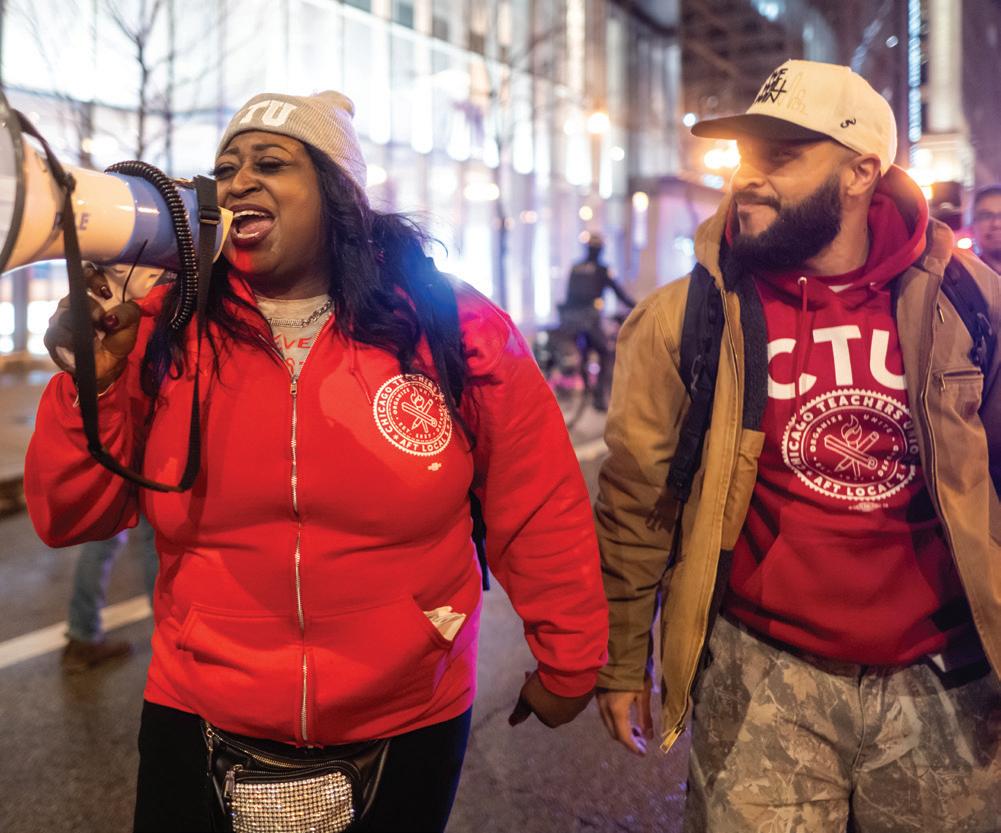
After a year at the bargaining table, the Chicago Teachers Union (CTU) and Chicago Public Schools (CPS) reached a tentative contract deal on March 31. The agreement guarantees improved sta ng and pay, smaller class sizes, and more.
According to the agreement, CPS will add 300 school counselors, 400 teaching assistants, 215 case managers, 30 bilingual support sta , and 68 centralized technology coordinators. The district also committed to hiring 90 librarians—doubling the number employed by CPS—and 24 fine arts teachers, who will teach at one of the 60 public schools without fine arts classes. In a win for academic freedom, workers secured the right of CPS educators to supplement their curriculum according to
and reduced lunch have access to field trips for free, and teachers won more release time to tailor their lessons for students, meet with parents, and discuss student needs with them.
The Illinois Educational Labor Relations Act of 1995 limited the bargaining power of CTU by only allowing them to bargain about things directly relating to working conditions. But since the section about that was repealed in 2021, in time for this round of contract negotiations, it expanded the bargaining possibilities for Chicago teachers.
“I’m most proud of this agreement because of the wins and the improvements it will make on the [students],” says Latoyia Kimbrough, internal counsel for CTU, who was on the bargaining committee. “I have a child, you know, in the third grade in CPS, and I’m excited for the improvements that this makes for her experience.” v
On April 4, State’s Attorney Eileen O’Neill Burke announced she was expanding a pilot program that allows Chicago cops to file gun possession charges without review from a prosecutor. The pilot launched on January 1 in the Seventh Police District, which covers Englewood and surrounding south-side neighborhoods. Last week, O’Neill Burke expanded the program to the Fifth District, which includes Roseland, Pullman, and Washington Heights.
At an April 5 meeting of the Seventh Police District Council, member Dion McGill called on the state’s attorney’s o ce to immediately suspend the program, conduct a comprehensive racial equity impact assessment, and commit to robust transparency and reporting requirements if the pilot moves forward.
The event, at the Ogden Park fieldhouse in Englewood, drew a strong crowd of community members and elected o cials, including Alders Raymond Lopez, William Hall, David Moore, and Stephanie Coleman. Also in attendance were deputy police superintendent Yolanda Talley and Seventh District commander Lewis Courts. Notably absent from the meeting was O’Neill Burke—a fact pointed out repeatedly by Lopez, Moore, and others in the audience.
Community members almost universally slammed O’Neill Burke for removing a layer of accountability from a police department with a long and documented history of abuse, coercion, and false confessions. They questioned why the policy was rolled out without any community input or even public notice.
“Elections have consequences, and we elected the wrong person,” said resident Mark Wallace of O’Neill Burke. —SHAWN MULCAHY
The Chicago City Council on April 7 confirmed Anthony Quezada as the next alderperson for the 35th Ward. The northwest-side district, which includes parts of Logan Square, Avondale, and Hermosa, has been without a representative since late February, when Mayor Brandon Johnson selected then alder Carlos Ramirez-Rosa to replace outgoing Chicago Parks District CEO Rosa Escareño.
Quezada brings to the post city government experience and close ties to the progressive northwest-side apparatus that has dominated area political contests in recent years. He spent more than six years working in Ramirez-Rosa’s o ce as constituent services director. He also organized with United Neighbors of the 35th

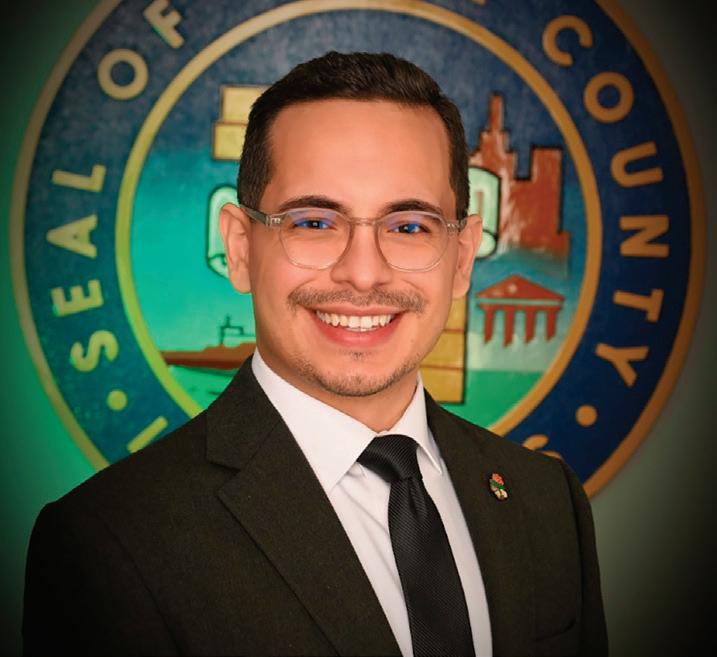
Ward, an independent political organization that Ramirez-Rosa helped launch after his election, according to WTTW, and has served as the ward’s Democratic committeeperson. He will likely prove a key supporter of Johnson’s progressive agenda at a time when a faction of conservative alders seeks to assert their independence and undermine the mayor’s policy platform. The 11 members to vote against Quezada’s nomination—Brian Hopkins, Anthony Beale, Desmon Yancy, Raymond Lopez, David Moore, Silvana Tabares, Felix Cardona, Gilbert Villegas, Brendan Reilly, Jim Gardiner, and Debra Silverstein—have publicly split from the mayor on a number of issues, from Johnson’s decision to cancel the city’s ShotSpotter contract to a planned $830 million bond issue for infrastructure projects.
Quezada became the first openly gay Latine person elected to the Cook County Board of Commissioners in 2022. Current City Council zoning committee aide Jessica Vasquez, another former Ramirez-Rosa staffer, told Crain’s Chicago Business she plans to seek Quezada’s open Eight District seat. —SHAWN MULCAHY
On strike!
After months of refusal from landlord Drew Millard and management company 33 Realty to meet, two tenant unions have voted to go on rent strike: Las Fuerzas Inquilinos de Broadway y Cuyler (FIBC) in Uptown and the Belden Sawyer Tenant Association (BSTA) in Logan Square.
According to an FIBC press release, the union organized after 33 Realty “informed residents . . . that they must move out to make
Realty agree to their demands, which include allowing tenants to remain in their homes.
On April 4, BSTA spokesperson Tory deMartelly emailed me an update: 33 Realty filed evictions against three BSTA members, including the father of a toddler. “Drew Millard has chosen to evict the only parents and small child living in the building. These people are cruel, and we won’t stop pushing back against their cruelty.”
way for luxury renovations.” Similar news struck BSTA in December. Some members of FIBC have lived in their apartments for 40 years, and all are Mexican, working-class tenants.
Twenty-four FIBC units are participating in the strike, which began on April 1. They’ll resume paying rent, they say, after Millard and 33
According to the All-Chicago Tenant Alliance, “rent money that is withheld from the landlord during a strike is not ‘spending money’ for tenants.” Instead, it accumulates together and serves as leverage. The ACTA Rent Strike Fund supports Chicago tenants on strike by covering legal fees incurred fighting evictions. To learn how to organize a tenant union and learn about successful rent strikes, consider reading Tracy Rosenthal’s book, Abolish Rent . —KATIE PROUT v
Make It Make Sense is a weekly column about what’s happening and why it matters.
m smulcahy@chicagoreader.com






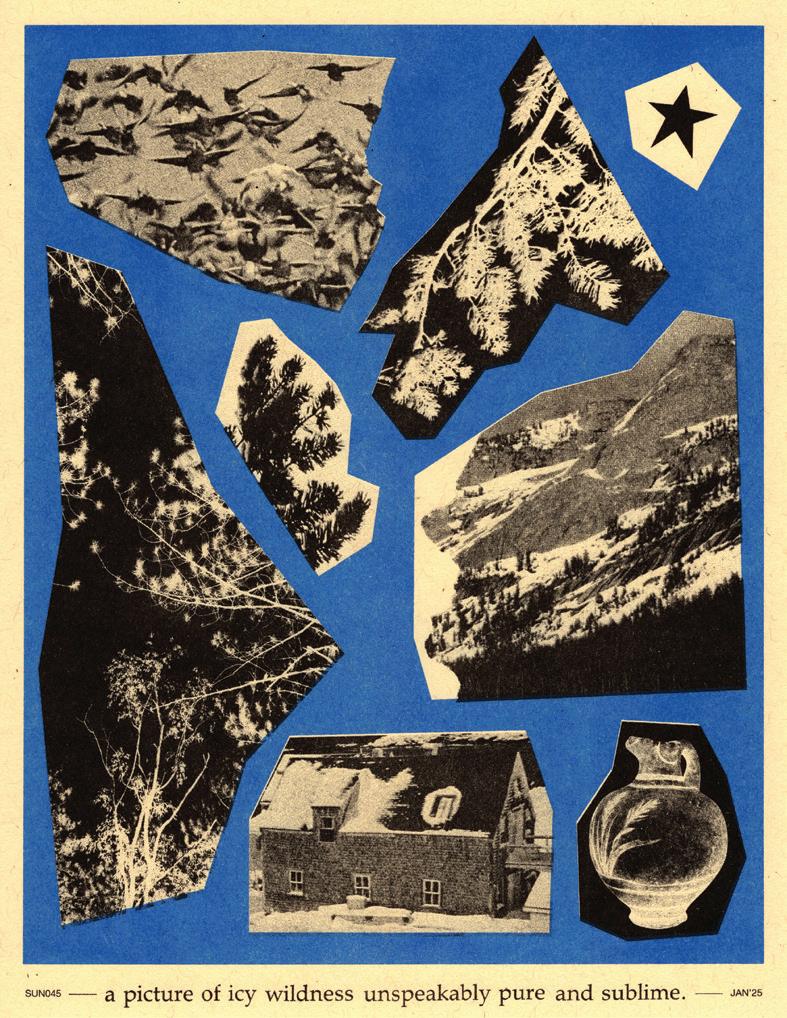

CORRESPONDENCE
Mail art clubs offer a connection that goes beyond the mailed object.
By SHIRA FRIEDMAN-PARKS
In mail art, the canvas is a postcard or a piece of paper in an envelope. Mail art highlights process and experience in addition to the product itself. It encompasses creation (writing, composition, choice of multimedia, paper, postal stamp, and envelope); transportation (the walk to the mailbox, the postal journey, physical additions by the mail service, delivery); and reception (retrieving, opening, enjoying). Mail art is both a ordable and egalitarian, not requiring the approval of galleries or museums; the only barrier for display is the cost of a stamp. Right now, when our mailboxes are mostly full of bills and advertisements, receiving mail art feels particularly special. Though artistically driven communication has existed as long as communication itself, Ray Johnson is considered to be the leading figure in the mail art movement. Johnson incorporated collage, (rabbit-heavy) illustration, and experimental layout into a global mail art network. Drawing on “a blyth spectrum of Americana, gossip, and mass
communications,” as Lawrence Alloway put it in Art Journal ’s 1977 collaborative report on mail art, Johnson’s work was distinct when he began in the 1940s and remains so today. A terminology to describe mail art approach wasn’t created until the early 1960s, when fellow mail artist Edward Plunkett named the growing network the New York Correspondence School. This was a tongue-in-cheek nod toward the concurrent abstract expressionism movement, also referred to as the New York School. Plunkett opulently described the art of correspondence as “an ephemeral, evanescent business,” which makes it “possible to communicate with someone on one level without knowing them on any other.” In 2021, the Art Institute featured Johnson’s mail art in an exhibition after acquiring a large archive of his work a few years prior.
Chicago’s role in the contemporary mail art ecosystem mainly began in the 1990s, and has ebbed and flowed since. Ashley Parker Owens ran the mail art magazine Global Mail, host-
ing an open call mail art show at ARC Gallery in 1993, and writing in a 1995 interview with Ruud Janssen, “It is important not to make this a secret club. There’s plenty of stamps for everyone.” Dorothy Patrick Harris, who used the moniker arto posto, also practiced mail art in Chicago in the 1990s, with a focus on rubber stamps and artistamps (artist-made pseudostamps). Starting in 1994, Michael Hernandez de Luna and Michael Thompson began a decades-long project of sending mail with politically charged artistamps, with the goal of them being returned to sender. From 2018–2020, the late Jason Pickleman hosted open call mail art shows at Lawrence & Clark, his noncommercial gallery. These ran annually, with the gallery’s mailman choosing the “best in show.”
The year 2020 spurred a resurgence of mail art (and mailed art) due to the isolation of COVID-19 and as a widespread response to the United States Postal Service (USPS) crisis created by then Postmaster General Louis DeJoy.
Exhibitions dedicated to mail art popped up around Chicago, such as “Hello USPS” by Purple Window Gallery and “Art in the Post” at the Elmhurst Art Museum. Motivated by a variety of factors—desire for creative structure, love for mail and tangible art objects, sudden need to stay financially afloat by alternative methods—artists and print studios started mail clubs. Five years later, the mail clubs remain. Many intend to continue indefinitely. Starshaped Press, founded by Jen Farrell, has operated as a letterpress studio in Ravenswood for more than 25 years. In September of 2020, Farrell started a multitiered monthly Print Club as a way to financially bridge the gap during what would usually be their busiest season. Print Club tiers range from a letterpress postcard mailed in an envelope to a packaged postcard, greeting card, print, and miscellaneous stationery. Constructed of vintage ornaments and type, these items are intended to be multipurpose. “I try to focus on the things that unite people,” she explained. “What can we all get behind? What themes are popular with people who care about letterpress?” Farrell’s goal with the tiered membership model was to have a low entry point (the lowest is $5 per month). What she found, however, was that people were eager to support the shop, with the most expensive membership tier ($27) being the most popular.
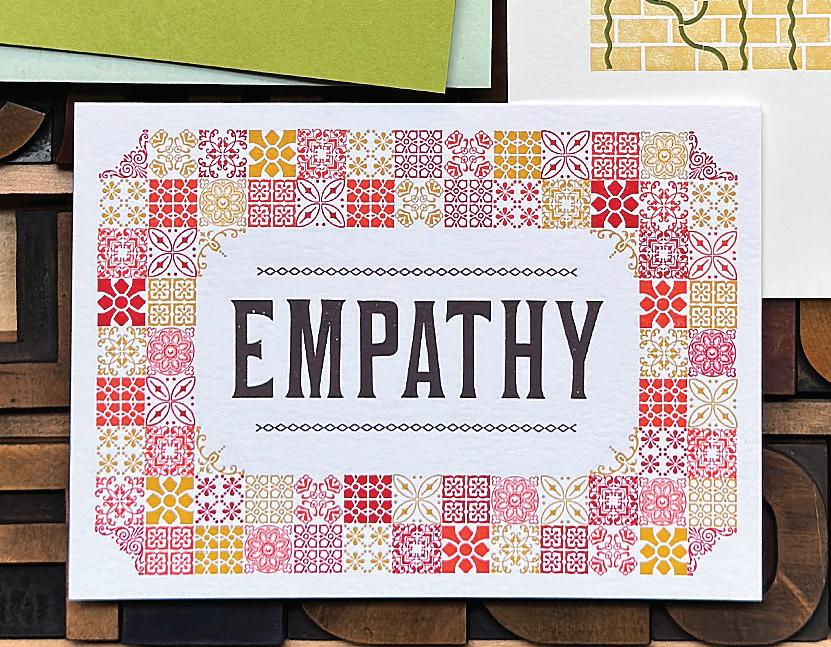
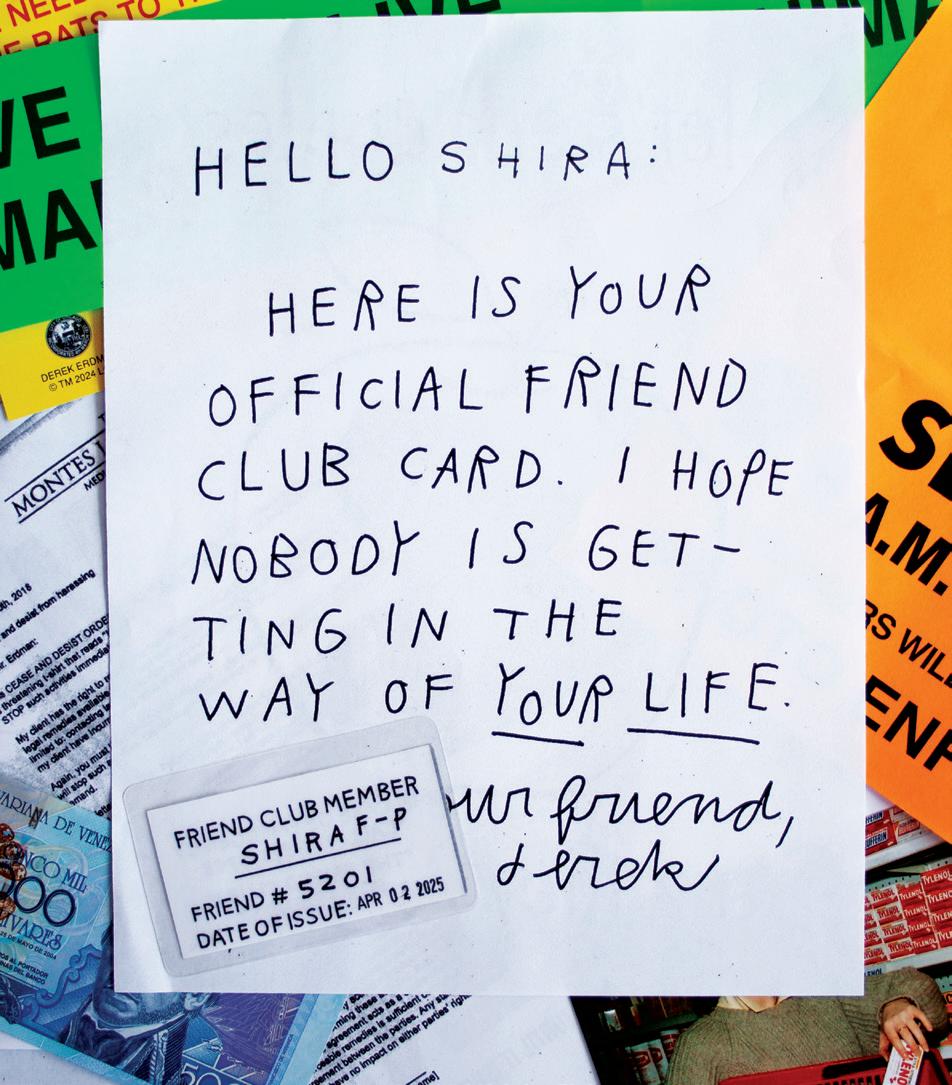
Clockwise from top le : Starshaped Print Club item (March 2025; Levels 3 & 4); Friend Club items; Fiorenza Friends Club sticker (January 2025); Feed The Rats (Friend Club item); Fiorenza Friends Club sticker (May 2025) Catdroool Club (May 2024); Personalized Friend Club membership card STARSHAPED PRESS; DEREK ERDMAN/ SHIRA FRIEDMAN-PARKS; FIORENZA ART; DEREK ERDMAN/SHIRA FRIEDMANPARKS; FIORENZA ART; CATDROOOL; DEREK ERDMAN/SHIRA FRIEDMANPARKS
Almost five years later, Starshaped’s mail club remains a large source of income for the shop. “I did not see it coming,” Farrell said, “that it would grow in popularity and become a big money generator for the studio.” There are currently around 250 Print Club members across all levels, mostly made up of “book nerds and librarians,” according to Farrell. “I don’t design things that are popular in the real world. It’s for a very niche crowd. So I hope the print club continues.”








to buy things. What can I do for them? Here’s something in the mail because we’re separated.” Friend Club does not follow a regular schedule—“There’s certainly no rhyme or reason for what happens,” Erdman noted—but that’s not to say he doesn’t approach it with thought and care. “I now view the world with what I can give to people in the Friend Club. If I go to a thrift store and find things I could send to Friend Club members, I buy them.”
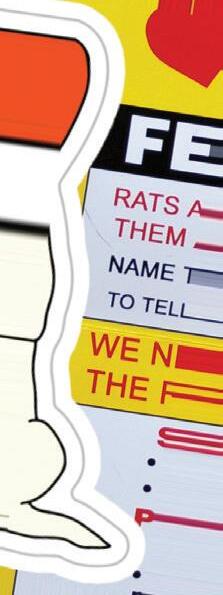
Derek Erdman’s Friend Club runs on a di erent model: it is free to join but involves a tedious enrollment process. “There was a time when I would get a dozen [applications] a day, so I really had to slow it down,” Erdman explained. “I’d say, ‘Oh, it’s closed this month, but if you call at 3 PM on Tuesday . . . ’ But people would actually do it.”
As of right now, to join the Friend Club, prospective members have to mail Erdman an application listing their name, address, favorite thing, and worst fear. Members then receive a numbered, laminated membership card. Within the Friend Club, there is a subsection of members who opt in to mail correspondence with Erdman. (There are currently around 2,350 card-carrying Friend Club members; around 800 of them have opted in to receiving mail.) On Erdman’s end, this in-
volves sending out prints, mazes, interactive surveys, postcards, and other objects he finds interesting. While belonging to the mail club is free, members often reciprocate by sending mail to Erdman in return. “I love getting mail,” Erdman explained. “I have dozens and dozens of pen pals. We trade postcards, even simple things, through mail. One guy just sent me a package of oatmeal today in the mail. It was just a stamp on a package of instant oatmeal with my address. I love coming home to a bunch of mail. I guess it’s the golden rule: treat others how you’d like to be treated.”
Erdman started Friend Club in 2020, inspired by and in honor of his friend, the late Jason Polan, who had hosted the Taco Bell Drawing Club. Friend Club began as a way to thank people who financially supported his art in other ways: “It’s really kind for people
Sunroom, a risograph studio and label run by Clare Byrne and Jacob Stolz, began its Monthly Flyer Club in May of 2021. Of the five mail clubs I spoke to, Sunroom has the largest membership. Sunroom’s 8.5 by 11 inch flyers alternate stylistically between photography and collage, and are consistently inspired by nature, seasonal changes, and their love for physical media. “I would call us collectors,” Byrne said. “We collect a lot of vintage magazines, records, and vintage art books. We flip through those all the time.” Their collecting is not specific to artifacts of the past: “Sometimes it’s as simple as picking up leaves in the neighborhood,” Stolz added.
Similar to other mail clubs, Sunroom’s Monthly Flyer Club was a response to a combination of situational factors. “It crossed o a lot of things for us: a) it supported the post o ce, b) we were able to connect o ine with people during the pandemic, and then c) as artists, it was a great way for us to keep up a consistent practice with built-in deadlines,” Byrne said. But it stuck: “We just loved it. We’ve been doing it for four years now. . . . It’s starting to feel like a visual diary for us.” Byrne and Stolz plan to continue the Monthly Flyer Club “in its exact form for as long as possible.”
Starshaped Press | Print Club starshaped.com/print-club-listings
Derek Erdman | Friend Club derekerdman.com/free.htm
Sunroom | Monthly Flyer Club hellosunroom.com/shop/monthlyflyer-club
Hannah Sellers | Catdroool Club catdroool.com/club
Elena Gatti | Fiorenza Friends Club fiorenzaart.com/products/fiorenzafriends-club

Hannah Sellers, cofounder of community art space Lot’sa and a “jack-of-all-trades” freelance designer, founded the monthly Catdroool Club in 2021. The club began with ten members and utilizes a variety of print mediums as a way for Sellers to set aside time for her own creative practice. “It was really sweet,” she said, “and it still is really sweet.” Since then, the club has grown to encompass 400 members, which Sellers attributes to a shared desire to interact with the physical world. “That’s where a lot of my inspiration comes [from], and I think that’s why a lot of people join any of these mail clubs. It’s to have something to hold onto that’s real.”
To accommodate this growth in membership, Sellers brought on a friend to help run the
Gatti explained. “What I’m exploring in my art, whether that’s a new subject matter, a new message, or a new technique. It reflects what I’m doing in real time, which I think is fun.”
She is primarily inspired by other junk journalers such as Martina Calvi (“who started the junk journal renaissance”) and Kalli (“the junk journal queen of Chicago”). Fiorenza Friends Club currently has 800 members, with a waitlist of 600. Each month, 20–50 slots open up. While Gatti enjoys the opportunity to connect with her audience, the ability to distribute her work at a lower price point, and the financial cushion during slow seasons, she worries the mail club takes too much time away from her main art practice. “This could be a main source of income if someone was really serious with it,” she said, “but I definitely don’t want to keep doing this. That would scare me. I want to keep painting.”
A central debate within mail art and mail clubs is whether or not to charge money. For some, the appeal of mail art is the lack of transaction. Arto posto, in her 1995 interview with Ruud Janssen, wrote: “Each person will handle her participation in the movement in her own way, and that is as it should be, in my opinion. . . . I like it that mail art really does not have hard and fast ‘rules.’ . . . Personally I like to stick with the ‘no money exchanges hands.’ . . . I can certainly understand that there are practical reasons WHY it occurs. It’s just not a part of the movement that appeals to me, nor one I personally care to get involved with.”
month, something’s gone missing or is just completely destroyed by a mail truck.” Nonetheless, people who run mail clubs tend to care for USPS and become close with the people who work there. Gatti said her local post o ce’s employees call her when new stamps come in. Erdman does one better. “I’m really good friends with all the people at the post o ce,” he told me, “so that’s awesome. They just wave me through. A lot of people hate the post o ce. I understand it’s very frustrating. The lines are terrible. But if you have your shit together and you bring them apples, which is what I do, they really learn to love you.”
Above all else, mail is an interactive experience, rooted in an affection for the tangible. “Part of the art piece is the experience of physically opening it, taking it out of your mailbox, seeing the stamp on the outside of it,” Byrne said. This level of interactivity was valued by all of the mail clubs I spoke with. Some take it a step further: Sellers of Catdroool occasionally sends out interactive prints, such as last February’s Valentine’s Day–inspired Mad-Lib love letter, or a build-your-own-picnic, with one print as the picnic blanket and a second with items to place on top. Erdman’s Friend Club members recently received an in-depth personality assessment made in conjunction with a University of Chicago student. “It was a little ridiculous, but it was actually scientific,” he assured me.
back end. She now exclusively uses a risograph for her prints, after co-acquiring one for Lot’sa. While Sellers does not want to grow Catdroool Club infinitely (“We all have this growth mindset in capitalism: grow, grow, grow, grow, and to what end?”), her penultimate goal is to be able to employ someone full-time (“for a job in art!”). Until then, she plans to continue “speaking to Chicago with my mail club.”
Most recently, in 2024, Elena Fiorenza Gatti started Fiorenza Friends Club, a monthly mail club inspired by junk journaling—the practice of memory-collecting through scrapbooking tangible items. Each month, members get some combination of a mini print, a sticker sheet, a “love letter” (assorted handwritten ramblings), and a bookmark. “I use it as a way to highlight what I’m really into that month,”
Erdman noted that his Friend Club is “certainly no way to make money. It’s only losing money.” But for others, mail clubs provide anywhere from a financial safety net to significant financial support. Gatti argued that “it is so important for artists to monetize what they have. We sometimes feel guilty about that, but it’s so hard to make a living just selling original art pieces. That’s not feasible nowadays.”
Similarly, Sellers sees mail clubs as a new pathway for artists to support themselves: “I hope the phrase ‘mail club’ becomes more ubiquitous. I hope that other full-time artists can be inspired to start their own mail club.”
Starshaped’s Print Club has become an integral source of income for the studio.
“It’s always kind of scary, just dropping it o , hoping it arrives,” said Stolz of Sunroom. Relying on the postal service inherently causes mishaps, such as lost and damaged packages, or items returned to the sender. “There’s a point where it is truly out of your hands,” Byrne of Sunroom added. Farrell always prints extra items, both to sell on their own and to accommodate losses: “Maybe every other

Interactivity in mail art dates back to Ray Johnson himself, whose mail art works would often include fill-in-the-blanks or requested actions on the receiver’s part. Despite the inconveniences, mail clubs o er a connection that goes beyond the mailed object. “There’s a lot to be really angry about right now,” Sellers remarked. “You don’t have to look far to find pain. To send people an envelope with something joyful in it that’s not an advertisement— it doesn’t get better than that.” v m sfriedman-parks@chicagoreader.com
A Neubauer Collegium exhibition hones in on a pivotal visit to the Field Museum.
“Project a Black Planet: The Art and Culture of Panafrica” has generated substantial buzz throughout Chicago since its opening at the Art Institute of Chicago late last year. Though the exhibition’s exploration of the Afrodiasporic solidarity movement has ended, its themes continue to reverberate at the Neubauer Collegium’s “Let’s Get It On: The Wearable Art of Betye Saar,” which dives into the realization of Pan-Africanism through an o -overlooked facet of Saar’s work.
Widely known for her assemblage artworks, Saar’s early practice conveyed the “‘Africanized’ goals of merging life and art.”
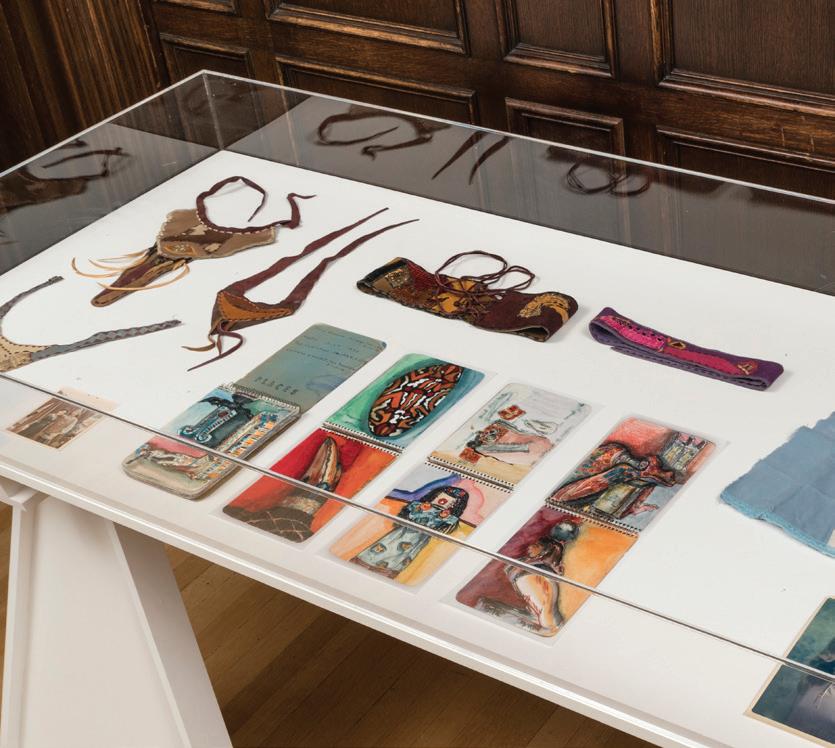
In the 1960s–70s, the years from which this work is drawn, Saar remained committed to exploring the sacred and ancestral properties of objects and artworks that held the potential of evoking a new consciousness for Black folks. This desire to explore a Black consciousness and spirituality through art was made real for Saar a er a 1974 visit to the Field Museum, where she experienced African art in a way that she never had before, noting the spiritual presence and connection within the work, very much aligned with the goals of Pan-Africanism. This excitement is evident in a small vitrine to the right of the gallery’s entrance; in it are her handcra ed jewelry, several photos of herself and family wearing the work, and a sketchbook filled with colorful notations and drawings, documenting the trip and conveying the feeling and spiritual presence she experienced within the museum’s walls.
Though the exhibition boasts the importance of her trip to the Field Museum, the connection to PanAfricanism is evidenced through the guts of the vitrine, which holds album covers designed by Saar and relics from her time as a costume designer, including colorful sketches, playbills, and posters from several plays that took place at Los Angeles’s Inner City Theatre, a space dedicated to performers and audiences dually excluded from access to mainstream performing arts venues. Interestingly, most of these items are dated before 1974, which signals that the themes she was exploring had lived within her practice before her trip to the Field. Perhaps this trip was the spark that allowed language to match what she had always known to be true of her practice. A er all, as she noted during a visit to the exhibition for Panafrica Days, “I started making art as a child, and I still make it. I don’t think it’s anything special, but I have fun doing it.”
—RACHEL DUKES “Let’s Get It On: The Wearable Art of Betye Saar” Through 4/27: Mon–Fri 9 AM–4 PM, Neubauer Collegium, 5701 S. Woodlawn, neubauercollegium.uchicago. edu//exhibitions/betye-saar
RYou are on Native land
“Woven Being” maps diverse but related Indigenous art.
The Block Museum’s monumental “Woven Being” is expansive yet concise, not so much a group exhibition as a mapping of diverse but related Indigenous art. To put it together, four artists with connections to Chicagoland—Andrea Carlson, Kelly Church, Nora Moore Lloyd,
“Let’s Get It On: The Wearable Art of Betye Saar,” Neubauer Collegium ROBERT HEISHMAN
and Jason Wesaw—worked with the museum to choose works to feature alongside their own. The result, which includes mostly but not exclusively contemporary Indigenous artists, is rich and generous with perspective.
Masterful woven vessels, made by Church, Cherish Parrish (Church’s daughter), and John Pigeon, are displayed throughout the galleries. In one corner, a trio of woven sculptures by Church infer links between the pollution and fragility of Lake Michigan, and the dozens of oil and gas pipelines laid beneath its bed, and the emerald ash borer, an invasive insect that devours black ash trees, whose bark has been used in basket-weaving by Native artisans for centuries. An accompanying video details the importance of harvesting black ash tree seeds in order to preserve this important tradition.
References to the natural world are bountiful. Water Carries Memory, a large-scale mixed-media installation by Wesaw composed of hanging ribbons of multihued blue above a strip of sand and ceramic pots, channels the lake, as do two hazy, sunset-like paintings by George Morrison. A small glass vitrine shows examples of the art of wigwas mamacenawejegam, or birchbark biting, which results in beautifully ornate, symmetrical flora and fauna designs.
Elsewhere, archival materials and more personal artworks offer glimpses into complex histories. A facsimile of the Chicago newsletter the Cherokee Speaker is displayed alongside a 60s-era propagandist brochure from the Bureau of Indian Affairs promoting the benefits of relocation and, by extension, cultural assimilation. Works by Lloyd make plain the tragedy of that forced assimilation. A back room displays a project inspired by letters her great uncle wrote to his niece, who was forcibly removed from her home to attend a missionary school. Her gorgeous graphic series “Remembering Ancestors” draws the names of her family members using Ojibwe syllabics painted on birchbark.
But it is Church’s wall-hung sculpture, installed at the show’s entrance, that sets the tone and presents the most important takeaway. Cutout black construction paper at the bottom of the sculpture allows the overhead light to spell out a message on the gallery floor: “You Are on Native Land.” —KERRY CARDOZA “ Woven Being: Art for Zhegagoynak/Chicagoland” Through 7/13: Wed–Fri noon–8 PM, Sat–Sun noon–5 PM, Block Museum, 40 Arts Circle, Evanston, blockmuseum.northwestern.edu v
westside bound 4
I gotta Lake Shore Drive, but comin’ down that 2-9-0
I hit Austin like South By Southwest
About mines, so the crew gon’ blow
Throwing fits like a mall need an outlet
Big Pivot, and if you don’t know
Hit the pavement, the stage anywhere we at
Know the name, when we say it, they’ll yell it back
Only the strong survive
From the neck of the woods that we come from
All through the city we run-run
For a fee it get fire like it’s fo-fum
Raps in the basement like Tigger’nem Brothers from the start, word to Genesis
From couches to Carolyns, limitless
One thing that it’s never been bigger than Pivot
By MFnMelo
MFnMelo is a Pivot member.
Poem curated by Frsh Waters. Frsh Waters from Chicago’s Westside is a writer, performance artist, & community outreach coordinator for Chicago youth arts non-profit John Walt Foundation and is a member of Chicago’s incomparable Pivot Gang.
A weekly series curated by the Chicago Reader and sponsored by the Poetry Foundation.
Opening Hours
Wednesday, Friday, Saturday: 11:00 AM–5:00 PM Thursday: 11:00 AM–6:00 PM
Blood Wolf Moon
Join us for an evening of poetry readings by Elise Paschen and Esther Belin plus artist talks by June Carpenter and Lydia Cheshewalla, followed by a reception.
April 10, 2025 at 6:00 PM
Exhibition Opening: Escaramuza, the Poetics of Home Escaramuza, the Poetics of Home is a collaborative work by photographer Constance Jaeggi and poets
Angelina Sáenz and ire’ne lara silva. The exhibition explores escaramuza, the team sport of women’s precision horse riding, addressing complex themes of identity, family, and gender with a lush combination of poetry and photography.
April 17, 2025 at 6:00 PM
Learn more at PoetryFoundation.org

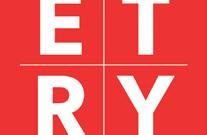


SCARY TOWN
Through 5/ 11: Thu–Sat 7:30 PM, Sun 3 and 7 PM; also Mon 5/5 7:30 PM, no show Sun 5/ 11 7 PM; the Clutch, 4335 N. Western, handbagproductions.org, $ 35 general admission, $ 43 VIP reserved
family dysfunction.
By KERRY REID
Stages of Survival is an occasional series focusing on Chicago theater companies, highlighting their histories and how they’re surviving—and even thriving—in a landscape that’s become decidedly more challenging since the 2020 COVID-19 shutdown.
David Cerda, the founder and artistic director of Chicago’s Hell in a Handbag Productions, has made a career out of camp—though, as he points out during our Zoom interview, “really good camp is unintentional.” Handbag’s style draws heavily on Theatre of the Ridiculous (a genre of broad satire/ homage that began in mid-1960s New York City with John Vaccaro’s Play-House of the Ridiculous and Charles Ludlam’s Ridiculous Theatrical Company) and is nothing if not self-conscious. From their first show—2002’s Poseidon! An Upside Down Musical, a send-up of the 1972 disaster-at-sea film, The Poseidon Adventure—they’ve been dedicated to what their mission describes as the “preservation, exploration, and celebration of works ingrained in the realm of popular culture via theatrical productions through parody, music and homage.”
Their long-running Golden Girls “lost episodes” franchise, which creates ongoing new (and often delightfully filthy) adventures for the beloved Miami quartet (all played by men), introduced them to wider audiences. Their 2019 production of The Drag Seed (inspired by the 1956 killer-child melodrama The Bad Seed) was remounted at New York’s legendary La MaMa Experimental Theatre Club in 2022. They’ve also gone sci-fi with 2023’s I Promised Myself to Live Faster; satirized musicals that sanitize poverty in last year’s Poor People!; and sent up Hollywood icons, most notably Joan Crawford. (Cerda is also the founder of the Crawford-influenced band the Joans and has played the Golden Age actress in several shows, including Christmas Dearest.) Cerda has shared writing credit as well as performed for many of these productions, earning his reputation as Chicago’s answer to actor, playwright, and drag sensation Charles Busch along the way.
found out by accident that my father wasn’t my natural father. And my mother denied it over years. Denied it, denied it, denied it.”
Cerda, who grew up the oldest of four kids in a working-class family in Hammond, Indiana, first figured out something was o at 13, when he discovered his birth certificate and found that his name on the certificate was his mother Bea’s maiden name—Vicari—and not that of the man he knew as his father, Robert Cerda. His mother dismissed it as a “clerical error.” But at 20, Cerda was sitting in a gay bar in Calumet City. “A woman came up to me and said, ‘I know you.’ And I was like, ‘What are you talking about?’ ‘I’m your sister. Your mother has visited our home and showed us graduation pictures. You’re David.’ It was my half sister that I didn’t know.”
To organize the full complicated story for the play, Cerda says he “wrote a timeline. It took me from age 13 to 59 to find out the full story.”
He confronted his mother about the bar encounter shortly after it happened.
“She got very angry. Said the woman was a liar. ‘I don’t know what you’re talking about.’ I was like, ‘Well, why would this woman say this?’ She just would not talk. She acted like I had attacked her. My brother and sisters are white with brown hair. And I’m the only one that had black hair and brown eyes and brown skin. I was a lot darker when I was younger. And I would ask about that
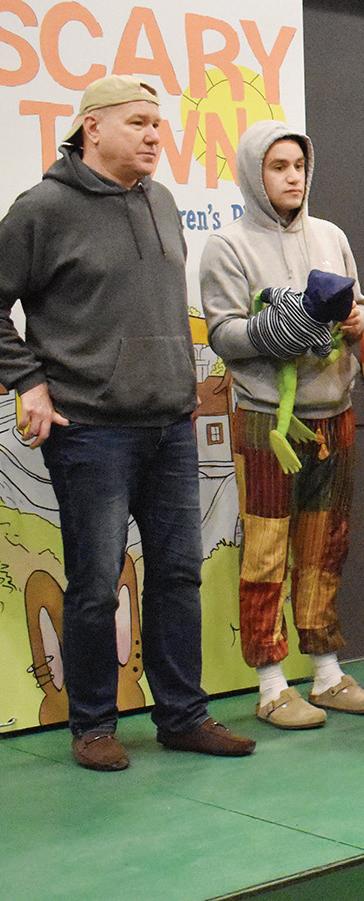
“My life is like a Hell in a Handbag show.”
But in Handbag’s latest, Scary Town , opening this week at the Clutch (a small space in Lincoln Square that the itinerant company usually uses for rehearsal), Cerda draws heavily on his own family history. And it’s a doozy. But since he’s still Cerda, that history is filtered through the lens of the cute anthropomorphism familiar to fans of children’s author and illustrator Richard Scarry.
“I’ve always loved animals wearing clothes,” Cerda says. “When I was little, I used to draw lady dogs with dresses and wigs. I was really into cartoons, and I thought I wanted to be a cartoonist when I was younger.”
“Scary Town is something I’ve been wanting to write for a long time,” says Cerda. “And now that I’m working on it and it’s going up, I know why it took me so long. It’s based on my childhood—a specific incident where I
occasionally. And they said, ‘Oh, you just turned out different.’ And so I believed my parents because that’s what you’re supposed to do.”
In the play, directed by former Handbag ensemble member Cheryl Snodgrass, a little brown bunny named Deven lives in Merry Town, “the happiest town where all the animals live in harmony and wear cute outfits.” But Deven, like the author, finds out a secret that blows up his life. (Cerda doesn’t appear in the show.)
Cerda says he and his mother had limited communication for several years after the bar story. But in 1993, after becoming sober, he began exploring the family secrets in therapy, including Adult Children of Alcoholics and Dysfunctional Families meetings.
The full story eventually came out, and Cerda notes with a laugh, “My life is like a soap opera. My life is like
a Hell in a Handbag show. I always tell people it’s like a Douglas Sirk film.” Sirk earned fame with his 1950s soapers like Written on the Wind and Imitation of Life—the latter forming the basis for Handbag’s 2018 production of L’Imitation of Life.
“My mother had me when she was 20 years old. The man ended up being married, and he had a family of his own. And that’s why my half sister is like three months apart from me. When [my mother] got pregnant—and I didn’t find this out until much later—when she got pregnant, I believe her parents forced her to put me up for adoption. Her parents are my nana and grandpa who I adored. She liked the Brown men. My mother would go to the East Chicago harbor
after I met my half sister. And it was more like, ‘And by the way . . . ,’” he notes. Not long after, he moved to Chicago, in part at his mother’s suggestion and with some financial help from her.
As he told Reader critic Tony Adler in 2012, after moving to Chicago, “I discovered clubs and the punk-rock, new-wave scene. I wore black eyeliner and fishnets on my arms and spiked my hair. I was sort of like a goth Jayne Mansfield.”
Cerda’s first artistic home in Chicago was with Kelly Anchors and Mike McKune, the married cofounders of Sweetback Productions (founded in 1994). Their sensibilities meshed with his—the first show he did with them was an unauthorized stage version of John
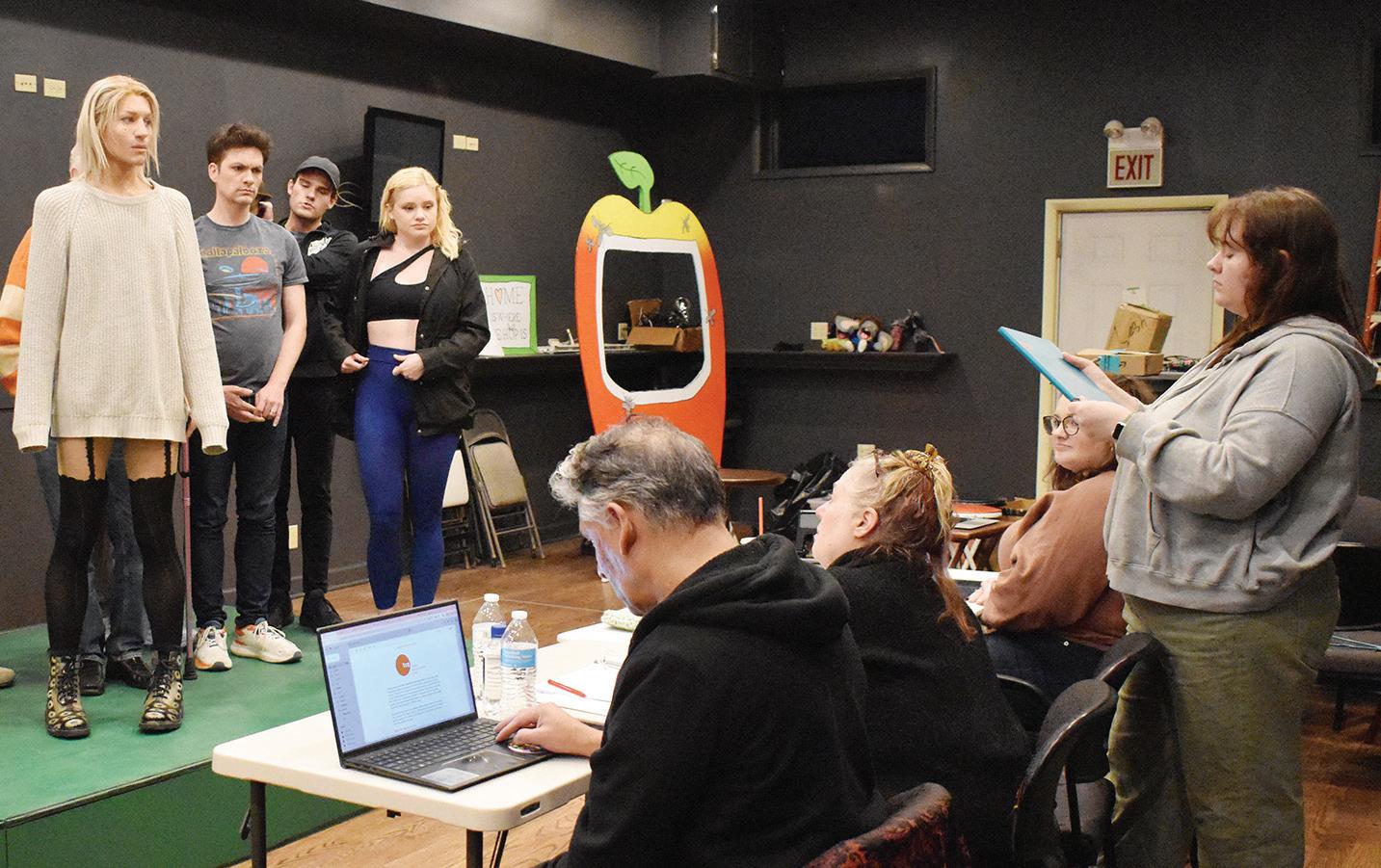
with her girlfriends and flirt with Mexican men.” Cerda adds, “I think the Catholic church had a lot to do with forcing my mom to give up her baby. And I was in an orphanage for six months. What happened was, my mother fought the Catholic church to get me back. It wasn’t easy apparently, but she got me back under the condition that I lived with my grandparents. She got a job and straightened out her life. And so my mother was going to beauty school, and I lived with my grandparents for I think four years. I was very, very close with them. I don’t remember leaving that house to live with her, because I imagine my mind is protecting me from that because I’m sure it was very traumatic. And then my mom met my dad, who raised me.”
Coming out to his parents added to what Cerda describes as a “chaotic” household. “Actually I came out to her when I was 20,


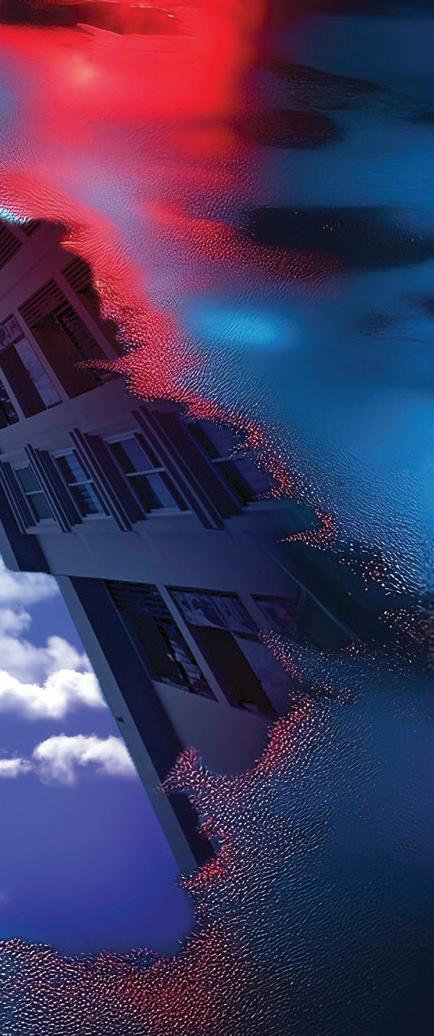
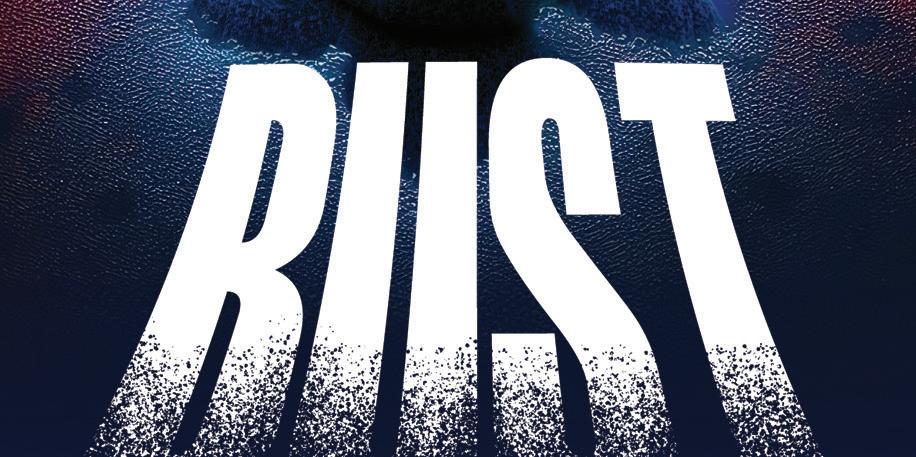


BY ZORA HOWARD DIRECTED BY LILEANA BLAIN - CRUZ
It’s not only hell that breaks loose in this ground-breaking, form-defying, laugh-out-loud new drama from Pulitzer-Prize finalist playwright Zora Howard.
Waters’s 1974 film, Female Trouble. “I was one of the hairdressers. I had a small role. And as I got to know her, I just said, ‘I have an idea for a show. And my first show I did with Kelly was a Russ Meyer tribute parody called Super Vixens, Go Faster, Kill.”
Cerda was on the board of Sweetback, but his theatrical family wasn’t devoid of dysfunction, either. In 2002, Cerda and fellow board members Steve Hickson, Pauline Pang, and Richard Lambert ejected Anchors and McKune from the company in the wake of allegations after the company’s acclaimed production of The Birds (a deconstruction of the Hitchcock film incorporating Camille Paglia as a character) that Anchors had become di cult to work with. As reported by the Reader ’s Deanna Isaacs, the four “got together, divided the assets, o ered her a like-it-or-lump-it deal, and told her to push o .”
Retta and Reggie are enjoying a quiet evening on the porch when their neighbor is pulled over by the police. Everything goes as you might expect—until the unexpected happens. A recording of the event goes viral, making everyone question reality in this funny, “daring and experimental” (Atlanta JournalConstitution) new play that explores what can happen when generational rage vanishes into thin air.
APRIL 19 – MAY 18


continued from p. 17
On a happy note, Anchors and Cerda buried their differences several years ago. And he credits her with helping him find his artistic voice when he needed it. “I also wrote a show in recovery called The 12 Stepford Wives. And that’s when I started believing, well, maybe I can do this. Because my recovery community and Kelly Anchors saw what I was writing and were like, ‘This is good.’”
Today, Handbag operates on an annual budget of what Cerda says averages about $200,000. He draws a salary of just over $43,000 as artistic director per their latest tax filings, and his partner, Chris Yourex, serves as board president. The ensemble numbers over 25, several of whom have been with the
that get a stipend to do certain things like Instagram and social media.”
Another challenge for Handbag is that their style of theater doesn’t lend itself to funding for community outreach and education initiatives. “That’s really important work to do, but you know, we can’t bring Valley of the Dolls to a school on the west side,” says Cerda.
With Scary Town , Cerda seems to be reflecting on his own unusual path through dysfunction and camp theater. “I wanted to tell my story, and I didn’t wanna do some lame kitchen-sink drama where it was like, Indiana: Osage County or something,” he says.
“I’ve been sober 30 years now, but I was this close to saying ‘fuck it all,’” says Cerda. “You know, I came out in 1980, ’81, so I was like,
“Scary Town is something I’ve been wanting to write for a long time. And now that I’m working on it and it’s going up, I know why it took me so long.”
company for years and make it their primary artistic home. (I’m not sure I’ve ever seen the indispensable Ed Jones, who plays Rose in the Golden Girls shows, at any other theater. Reader critic Dan Jakes once wrote of Jones’s incandescently loopy onstage persona, “Imagine Mrs. Garrett from The Facts of Life, only ten times Mrs. Garrett-ier.”)
Staying itinerant has given the company flexibility in good years and bad. They’ve performed at the now-defunct Mary’s Attic space at the old Hamburger Mary’s in Andersonville, at the Chopin Theatre, at the Center on Halsted, and at the Leather Archives & Museum auditorium (for 2019’s The Golden Girls: The Lost Episodes, Vol. 5–SEX!).
Cerda notes, “The Golden Girls is the most varied audience demographically, because everybody likes The Golden Girls . Seniors, gays—gays and grays. A lot of people of color love The Golden Girls. I love doing it [Cerda plays Dorothy Zbornak], but I don’t wanna be known as the Golden Girls company.”
“We don’t really have the infrastructure to buy a building and have people, the boards, and all the politics and everything that comes with that,” he says (perhaps ironic given the old history with Sweetback). “We have, like, a core group that does things with Handbag, and everybody else is super busy doing their own lives. It’s really hard when most of them are volunteers. We pay people in the ensemble
The Book of Grace explores the boundaries of optimism in the midst of rage.
Suzan-Lori Parks knows how to interweave domestic conflicts within the larger framework of our national madnesses and obsessions, of which white supremacy and its violent effects (external and internal) on non-white people is the most obvious and toxic. In the Pulitzer Prize–winning Topdog/Underdog, two Black brothers, Lincoln and Booth, excavate their shared past against the backdrop of racism and poverty. (Lincoln, the sole provider for the duo, works as a whiteface Abraham Lincoln in a shooting arcade; in The America Play, Parks also invented a Black character who works as a gravedigger and a Lincoln impersonator.) In Father Comes Home From the Wars, Parts 1, 2 & 3, she used Greek tragedy as the framework for the story of a former enslaved man, Hero (also called Ulysses) who marched off to the Civil War—on the Confederate side—while exploring war’s lingering effects on soldiers and civilians.
pier endings, and we hope that grace can prevail over anger and paranoia. Parks’s deliberately obscure ending leaves us wondering about that possibility (especially now). But without a doubt, Broadnax’s cast leaves everything on the stage with unforgettable and sometimes heartbreaking clarity. —KERRY REID THE BOOK OF GRACE Through 5/18: Tue–Fri 7:30 PM, Sat 3 and 7:30 PM, Sun 3 PM; also Wed 5/7 2 PM; no shows Tue–Wed 4/8-4/9 and 4/22-4/23, Wed 4/9 7:30 PM, Wed 5/7 7:30 PM, Sat 5/10 3 and 7:30 PM, Sun 5/11 3 PM, or Tue 5/13; audio description and touch tour Sun 5/4 3 PM (touch tour 1:30 PM), open captions Sat 5/3 3 PM and Thu 5/8, ASL interpretation Fri 5/16; Steppenwolf Theatre, 1650 N. Halsted, 312335-1650, steppenwolf.org, $20-$102
No Such Thing puts an older woman’s relationships in the spotlight.
‘Great, I’ll get AIDS and die, and then I won’t have to deal with this [family pain] anymore. I’ll get benefits, and I can party until the end.’ That was my plan. I was afraid to do anything. I kinda wanted to perform and write, but I was just too terrified to do it.”
It’s fortunate for Chicago theater fans that his plan to sign out early didn’t work, and it’s hard to imagine the acerbic Cerda as ever being afraid of speaking his mind. As for his family life: His mom died on Thanksgiving morning 2013 (a year after his brother, Michael, died suddenly), but Cerda is close with his remaining family.
In 2023, Cerda finally met his biological father, who is still alive, and filled in some blanks in his mom’s history as well. “He gave me a lot of insight about my mom, and in just talking to my mom’s best girlfriends and everything, I found out she was a really free spirit. She loved to go out, she loved the latest trends. She danced, she won dance contests. She was kind of a wild child, and she had dreams of doing this and that and traveling. But after she got pregnant with me, I think that ruined her. It stopped all that.”
Maybe the only roadmap through Scary Town and to long-term survival (personal and artistic) lies in facing the truth and making it larger than life—with cute furry animals. v
m kreid@chicagoreader.com
The Book of Grace, first produced in 2010 and now in a revised version at Steppenwolf under the direction of Steve H. Broadnax III, takes us into the xenophobia, toxic masculinity, and desire for dominance at all costs in our current national malaise. Set at the southern border, the title refers to Grace (Zainab Jah), a wife and waitress who scribbles her thoughts and stories into a notebook. Grace’s husband, Vet (Brian Marable), is a border officer so obsessed with his job that their television is perpetually set to a livestream of the border fence, which he calls “a modern miracle.” He’s about to receive a medal for intercepting a truck filled with what we’re told were bad guys.
When Vet’s son from his first marriage, Buddy (Namir Smallwood), shows up a er a 15-year separation, it’s obvious there is a lot of unresolved anger and disappointment. “Grace says I’m a work in progress,” Vet tells his son, to which Buddy responds, “I say you’re a piece of work”—emblematic of the sharp ripostes and wordplay that Parks specializes in. Still, the optimistic and peacemaking Grace seems poised to help both men reach a rapprochement. She even refers to their living room as “Camp David.”
But the damage between father and son, the fence of grievances built from years of disappointment and resentment, remains insurmountable. Smallwood—who played a vet with mental illness in Tracy Letts’s Bug at Steppenwolf and an orphaned introvert in Eboni Booth’s Primary Trust at the Goodman—has staked out his place as one of our finest portrayers of unsettled souls, and his performance as Buddy is a potent mix of rage, yearning, self-doubt, and vengeance. (He’s returning to Steppenwolf next season in a revival of Topdog/Underdog.) Marable’s Vet is fearsome in his own fearfulness. Like so many men in the U.S., he’s scared of losing his hard-fought place in the hierarchy and is determined to hang onto whatever power and control he can, within and outside his home.
Which means that Grace, like so many people trying to do good and find their voices in a world that tries to shut them down and bury them, is le to try to mend the ri s. Jah’s performance is revelatory, even though we don’t get much of a backstory for Grace’s own life before she married Vet. We see her reading from her book, the titles projected on three screens that also variously resemble battered fences and tattered billboards around the in-the-round set by Arnel Sancianco. She reimagines stories she hears at the diner to create hap-
Lisa Dillman’s No Such Thing, now in a world premiere at Rivendell Theatre Ensemble under Malkia Stampley’s direction, intertwines two primary plots: an extramarital liaison between Ren (Susan Gosdick) and a younger man (Josh Odor) whose real name she doesn’t even know, and the unfinished business between Ren and her adult daughter, Olivia (Jessica Ervin). While neither strand feels fully fleshed out, Dillman’s story shows a firm understanding that getting older (especially as a woman) doesn’t mean you’re any less capable of sexual desire, and that being a mother means you never stop worrying about your heart walking around outside your body in the form of another person.
The younger man, who we eventually learn is named Fallon, revels with Ren in taking on the names of different literary characters for their hotel assignations. Ren is a screenwriter who hasn’t had any success in several years (as her agent, Marilyn, played by Cheryl Hamada with a charming blend of no-nonsense straight talk and genuine concern, keeps reminding her). The stories she and Fallon share jump-start her creative juices again. But her concern about Olivia, whose adolescence was marked by eating disorders, mental illness, and very bad choices in boyfriends (and Olivia’s resentments about her mother’s inability to trust her to make her own decisions) keep getting in the way. Meanwhile, Ren’s husband, Ted (Matt DeCaro), largely stays out of it—until he doesn’t.
Stampley’s intimate honest staging makes up for some of the undeveloped plot points. (We don’t learn much about Ren’s past career away from her personal relationships.) Gosdick wisely doesn’t try to play for our sympathies with Ren, who has clearly made plenty of mistakes while trying to protect her daughter and her own voice. She is at times controlling and self-absorbed, but her love is never in doubt. Ervin makes us feel the pain of walking through the world, knowing that the person who gave you life will always think of you as damaged. Thoughtful stories about older women wrestling to keep all the parts of their lives in sight, even as society tries to erase them completely, are rare enough that Dillman’s No Such Thing is ultimately a refreshing and welcome portrait. —KERRY REID NO SUCH THING Through 4/27: Thu–Fri 8 PM, Sun 3 PM; Sat 4 and 8 PM; also Sun 4/13 3 PM (mask required performance), Mon 4/21 8 PM, and Sun 4/27 3 PM; Rivendell Theatre, 5779 N. Ridge, 773-334-7728, rivendelltheatre.org, $39 ($17 students, educators, military/veterans, and industry on first-come firstserve basis; $28 seniors) v
Film and television production can be a significant pollutant, but companies like Ecofixr are setting greener standards locally.
By S. NICOLE LANE
From The Bear to The Blues Brothers, Chicago is an entertainment industry town that generates an annual $700 million in economic impact across 50 wards and sustains approximately 20,000 jobs. But along with the success of jobs, money, and production comes a heaping amount of environmental waste.
For people not fine-tuned to the entertainment world, it may not seem like an obvious culprit. But the film industry in Los Angeles, for example, has a greater impact on pollution in the city than aerospace manufacturing, clothing production, or the hotel industry.
On average, movie sets generate 72 tons of food waste, often including large amounts of plastic just from water bottle usage. Then, there’s chemical waste from developing film and energy consumption from lighting. Planes and transportation taken by crew members and actors all contribute to a large carbon footprint, according to a 2006 study at the University of California, Los Angeles. The list goes on.
However, in recent years, there’s been an uptick in people taking charge of creating zero-waste sets, with Hollywood films like The Amazing Spider-Man 2 (2014) and Girls Trip (2017) ensuring sustainable production. The Spider-Man film documented its work on X (formerly Twitter) under the handle @EcoSpidey. The filmmakers ultimately won the Green Seal award from the Environmental Media Association for their e orts. And Girls Trip diverted 600 pounds of catering food from their set to feed 500 homeless people in New Orleans.
Cities like New York and Los Angeles tend to be more watchful of their impact; however, Chicago’s waste has fallen under the radar. With the third-largest movie and recording workforce in the country, Chicago doesn’t have as many sustainability companies as either coast, resulting in fewer actionable initiatives for future greener production.
Ellen Domonkos White, the founder of Ecofixr, the first Chicago-based sustainability company, says, “There are a few possible reasons why the midwest/Chicago film industry has underreported sustainability data. First, many productions either do not incorporate sustainability e orts or fail to measure those efforts. Additionally, studios tracking their initiatives often do not release data specific to Chicago-based productions.”
White has more than 15 years of experience in the entertainment industry. In her work, she noticed that valuable resources were being tossed into landfills, so she started researching whether anything was being done to resolve the issue. From there, she discovered that people like her mentor, Kris Barberg, who runs the LA-based company EcoSet, have been actively working to help the industry for years.
She decided it was time for the Second City to adopt this standard, too. “I wanted to make a di erence for the industry and the future of my son and other budding filmmakers,” says White.
A new survey published by Ecofixr says that a single day of tentpole production—shooting a high-budget, high-profile film or television show—can generate 33 metric tons of carbon dioxide, enough to fill seven Olympic swimming pools.
Local companies that work with Ecofixr have experienced resource recovery. “We’ve rescued substantial food and materials to give back to the community,” explains White. “Two other major initiatives we’ve been advocating for are eliminating single-use plastics and adopting clean energy. There are many excellent alternatives to diesel generators, and we’re excited to see them starting to be integrated on set.”
One such collaborator is Filmscape Chicago, an educational nonprofit that works with filmmakers and folks in the television and production community, offers classes yearround, and hosts an annual event in June at
CineCity Studios. The event is one weekend of free classes and exhibits on a range of topics. In 2024, they had workshops on virtual set lighting as well as a cinematography panel from crew members on The Bear Ned McGregor, the board president of Filmscape, says that with film, you only shoot once, and then it’s done. “The nature of film is that, today, we need to be here, and so we build that set, and we’re never coming back. So, OK, what happens to that set?”
And in television, on a day-to-day basis, there can be one hundred people on a show, depending on the size of the production. Beyond the camera work, there are hairstylists, prop people, grips, makeup artists, set dressers, truck drivers, electricians, painters, and swing gangs. “There’s gotta be food for these folks,” says McGregor. “There are trailers for o ces, trailers for bathrooms—every department has a trailer with its stu in it.”
And each of these trailers has a generator, oftentimes gas, attached to it. “So, that’s a lot of fuel that’s being consumed. It’s all very significant,” he says.
At last year’s Filmscape annual event, sessions discussed green options for production. McGregor says that on the exhibiting show floor, folks showed off highamp-hour batteries and energy-e cient lighting.
“Everything’s moving towards LED in the lighting world, and so it’s much more possible to run that in a battery scheme than it was ten years ago when everything was more what you think of as an ‘old-school’ light bulb. So it’s becoming a lot more feasible for the whole production,” says McGregor.
used to have paper programs, but we moved to an app environment. So we’re not just printing out a lot of materials that are thrown away. We had recycling on site,” McGregor explains.
Filmscape also partnered with Liquid Death, a canned water company, to avoid single-use plastic. The event’s food trucks o ered vegetarian and low-meat options, since livestock in the U.S. produces 3.2 million metric tons of methane, a potent greenhouse gas contributing to climate change. A 2024 Food & Water Watch fact sheet wrote that this number is comparable to driving around the equator 28 million times.
The original plan for the event included electric power for the entire weekend, but
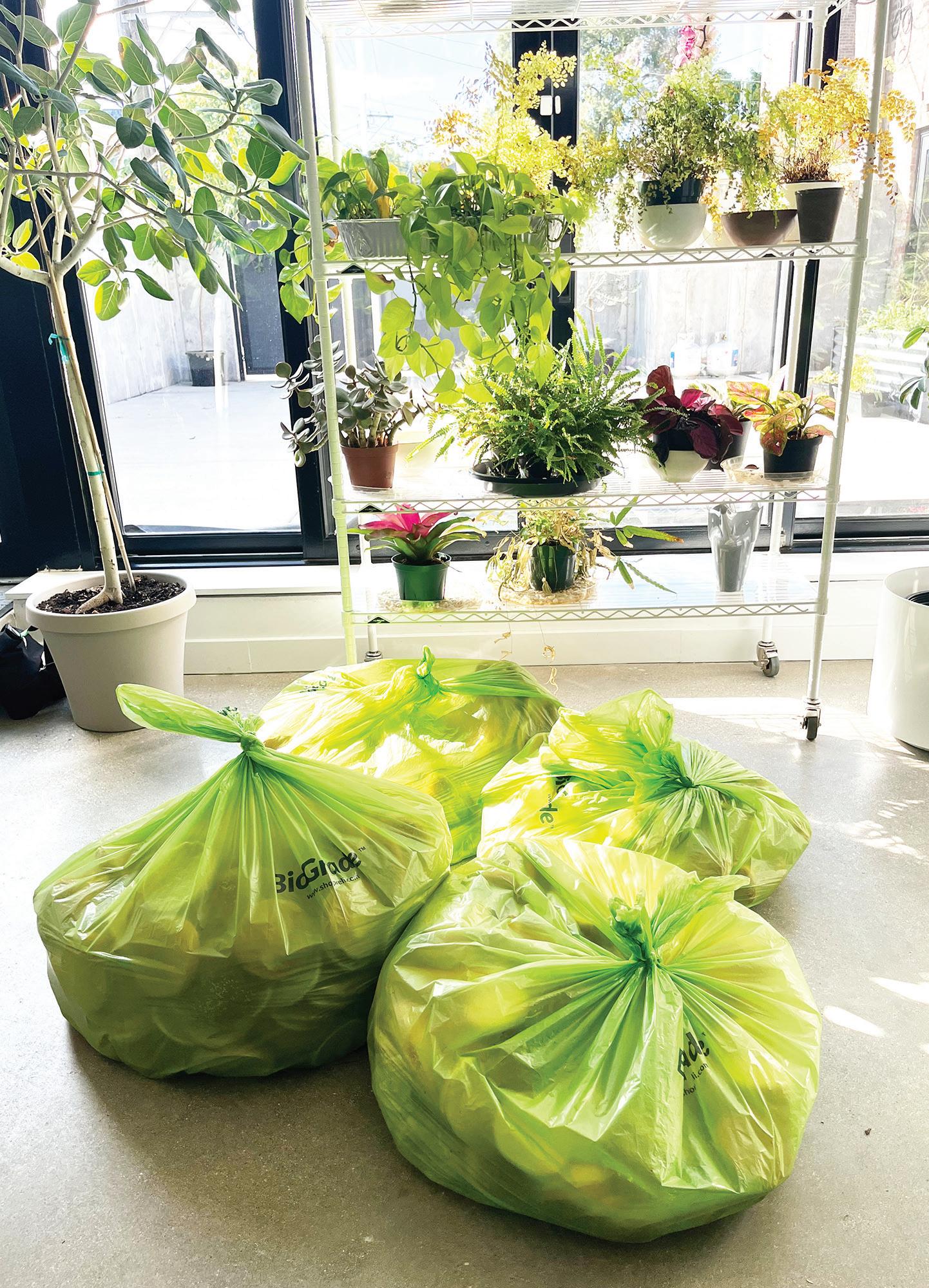
Since Filmscape is a nonprofit and not a production company, its event waste is a little di erent from what occurs on film or TV sets. Still, for their show in 2024, they partnered with Ecofixr on a green initiative.
“We did the lowball stu pretty quickly. We
due to an equipment issue, Filmscape was forced to run on diesel. For future events, like this year, they plan to have exclusively battery power.
An overall worry for some in the entertainment industry is cost-effectiveness. McGregor says, “If we go electric, we don’t have fuel costs.”
Fuel is a significant expense for Filmscape,
continued from p. 19
as they run for three entire days on generators. On average, one diesel generator can cost $200 a day. “That’s nothing for a production, but we’re a tiny nonprofit,” he says.
Core SWX, a New York- and LA-based company that makes batteries and power products for filmmaking, has a cost comparison for its newest battery product, MoXIE Solo ($6,495). Its 2.5-hour charge time only costs 89 cents. In comparison, a Honda 3000 gasoline generator ($2,000) consumes 0.479 gallons of fuel per hour and costs $1.79. A fuel generator will consume, on average, around 20 gallons of diesel per 12 hours. Film sets vary in how many generators they need, but a commercial film set typically requires two, and big productions could include 20 or more. Moreover, gas generators have a noise level of 73 decibels, similar to a washing machine. Therefore, they need to be placed further away on set for sound and air quality.
Most green initiatives, no matter the industry, come with an up-front price tag. “It is always going to be more expensive to have options that aren’t just putting everything in a trash bag at the end of the day. It is more difficult to sort through waste,” McGregor says.
In 2024, the Sundance Institute came to Chicago with three days of programming across four locations in the city. During the weekend, they worked toward eliminating single-use plastics, increasing food donations, and opting out of booking first-class flights for events. Working with a 91 percent waste diversion rate, the Sundance Institute was able to compost, recycle, or reuse 200 pounds of waste. They saved 40 pounds of food, which was used for 34 meals.
Nevertheless, the event still produced 32.14 metric tons of carbon emissions, showing how much more work still needs to be done. But hard work requires a starting point, no matter how painful or expensive. White says, “By making eco-conscious decisions from the outset, you’ll not only achieve better results and reduce costs by addressing ine ciencies but also integrate sustainability into each department’s decisions and foster a culture of environmental awareness among the cast and crew.”
We know Chicago as a TV town, with NBC’s Chicago Fire and Chicago P.D. notoriously filmed here. But it’s also a huge location for commercials and smaller production companies. McGregor says that because these companies made investments in diesel generators, which were more available when they started, it’s been di cult for them to change
moving forward.
McGregor says that a big shift will happen once smaller production companies embrace the change from diesel to battery, but he knows change like this doesn’t happen overnight.
And, of course, going green isn’t always as straightforward as going electric. There are power issues, as film sets need high power outputs over a long period of time for batteries. There are also larger concerns about still using fossil fuels to generate electricity and human rights violations that occur while using fossil fuels to produce lithium batteries.
That’s why White and McGregor are both working together and separately to educate folks about where to even begin and how to make sustainability a reality on set.
“For those ready to make a serious commitment to improving their processes, start at the very beginning of planning. Make sure your budget includes sustainability considerations, particularly allocating funds to hire someone to manage sustainability efforts,” advises White.
Things seem to be changing in Chicago.
On March 27, Ecofixr, the Independent Film Alliance, the Chicago Department of Cultural A airs and Special Events, the Chicago Film Office, the Chicago Department of Environment and Sustainability, and One Earth Collective hosted the Sustainability Now! Summit + Expo. The event was focused on educating filmmakers on reducing environmental impacts without digging too deep into their pockets, with keynote speakers, clean-energy demonstrators, and industry leaders, including a video speech from actor and environmental activist Ed Begley Jr. and his daughter, Hayden Carson Begley.
On April 25, Kinowerks, Ecofixr, and midwest photographer and storyteller Jason Lindsey will host the Green Frame: Sustainable Filmmaking for a Changing World at Kinowerks Studio to inspire more local environmental workflows.
These events signal the larger-scale shift in how Chicago filmmaking is becoming a little more green. Ecofixr is kicking o a conversation that’s crucial to the future of Chicago’s standards and how we can keep up with our competitors on both coasts.
“As the old saying goes, ‘You can’t manage what you don’t measure,’” White says, “which underscores the need for more reporting on sustainability efforts within our local industry.” v
m letters@chicagoreader.com





Apologies for not writing a column last week—consider this a two-week catch-up, one informed by a stretch of particularly immersive (and in some cases contradictory) viewings. In fact, the past couple weeks have reminded me of cinema’s capacity to withhold, o er, and defy clarity. Sometimes, you watch a film and walk away with a new understanding; other times, you leave with more questions than answers.
Further researching Trinh T. Minh-ha’s What About China? (2022), which screened two weeks ago as part of Conversations at the Edge at the Gene Siskel Film Center—and at which the revered Vietnamese filmmaker was present—I came across a synopsis (on IMDb of all places) that calls it “a hugely imaginative cultural critique of China that resists the idea of a single historical narrative, instead evoking the plurality of indigenous perspectives.” I’m not usually one for parroting summaries, but the above very neatly describes an otherwise ethereal, poetic film that lingers in my mind even as it actively defies interpretation.
Perhaps my least favorite part of writing about movies is when I have to summarize the film in question. I find it limiting, trying to reduce something so expansive to a few neatly digestible lines. Yet sometimes I also find myself relying on those very synopses—especially when writing days after seeing something, struggling to recall its shape, its movement, or even its mood. In this case, the description opened up space for me to think about the film as a kind of refusal: a refusal of conventional documentary narration, of the ethnographic gaze, of the idea that a nation or

culture can be made legible through images alone. What About China? lingers in the mind like an impression or a question one hasn’t yet figured out how to ask.
By contrast, Ulrike Ottinger’s Taiga (1992)— which I saw over the span of three days at Doc Films at the University of Chicago—is almost shockingly direct, at least in its structure and duration. The nearly nine-hour documentary depicts the taiga region in northern Mongolia and the nomadic Tsaatan people who live and move through it. Split into manageable chunks, the film never once felt like a slog. It’s purely the stu of life: daily rituals, long silences, quiet moments of work or rest, the wind. It too resists narrative in the traditional sense, but not in a way that obscures or elides. Instead, it quietly insists on presence—ours, theirs, Ottinger’s. Watching it, one feels not so much transported as returned to something elemental, tactile, real. More recently, I saw a double screening of Shohei Imamura’s Ballad of Narayama (1983) and Mel Brooks’s Blazing Saddles (1974), also at Doc. It’s a pairing that feels hilariously unhinged on paper—brutalist folklore followed by anarchic and somewhat dated satire—but maybe it’s exactly right. Both are transgressive in their own way, confronting social mores through exaggeration, absurdity, and an element of formal control. Why not let them sit side by side? Cinema contains multitudes.
Until next time, moviegoers. —KAT SACHS v
The Moviegoer is the diary of a local film bu , collecting the best of what Chicago’s independent and underground film scene has to o er.
A Minecra Movie knows it was cra ed from a video game with no real story—and it spends all 101 minutes scrambling to prove it deserves to be a movie at all. Instead of unearthing treasure, the movie digs itself a hole so deep in references, chaotic plotting, and forced humor that not even a diamond pickax could save it.
The titular sandbox video game took the 2010s by storm, immersing players (including myself) in a pixelated world made of clunky, colorful blocks stacked across sprawling forests, vast oceans, towering mountains, and, of course, underground caves. Players interact with the environment by smashing and collecting these blocks, cra ing tools, and bringing a world to life—brick by brick. Its simple design made it one of the most approachable, beloved games in the last two decades. Unfortunately, it’s now Hollywood’s latest money grab: another half-hearted video game movie.
Jack Black plays Steve, the main character of the original Minecra , though it’s tricky to say “based on” because the player character, Steve, doesn’t have much of a backstory. The movie’s first mistake was tossing out the clean slate, where it could’ve subtly built a story around him. Instead, it opens with a hyperdirect monologue announcing that Steve yearns to explore the world beyond his ordinary life, and a er quitting his job, he discovers a mysterious cubed “orb” that transports him to the Minecra dimension known as “the Overworld.” He quickly falls in love with living there, wanting nothing more than to create and build. However, his plans are interrupted when he is captured by Malgosha (Rachel House) and her army of humanoid demon pigs. To destroy the Overworld, the pig-witch antagonist needs the orb.
A er a clunky and painful exposition, A Minecra Movie introduces us to its protagonists: a buff, burnedout video game champion played by Jason Momoa; a dynamic, multitasking woman-about-town portrayed by Danielle Brooks; and two orphaned siblings, brought to life by Emma Myers and Sebastian Hansen. In true ragtag-team fashion, the four are united by a series of dramatic events and find themselves face-to-face with a portal to the Overworld. Once there, they meet Steve and embark on a quest to protect the precious cubic world from the pig sorceress. But really, this quest is gag a er gag, pinned up by homages to its video game origins and atonal comedic relief across the board. Sure, it’s a kids’ movie, and yes, its moral about the importance of creativity is essential. But, in the end, A Minecra Movie is fundamentally contradictory. It’s regurgitative, bastardizing an existing idea rather than spending time creating something new. A Minecra Movie feigns creativity by hollowing out a name brand and inserting a zombified story that does little more than capitalize on (or cannibalize) the name. —MAXWELL RABB PG, 101 min. Wide release in theaters
Việt and Nam is a dreamy and meditative exploration of loss, grief, and the lingering remnants of war. The title characters, played respectively by Đào Duy Bảo Định and Phạm Thanh Hải, are two coal miners in rural north Vietnam in 2001. The lovers share daily moments of intimacy, explicit in the mine and restrained outside of it. A tender melancholy hangs over their relationship as Nam plans to soon leave the country—Việt both mourning and questioning his decision.
Early on, a television broadcast shares the details of still-missing soldiers and the family members searching for them, while Nam and his mother, Hoa (Nguyễn Thị Nga), move around their home forming coal briquettes. We soon find out, through Hoa’s recounting of her dreams, that Nam’s father is among those who died decades earlier, his grave still unfound. Accompanied by Việt and the father’s former soldier friend Ba (Le Viet Tung), the family travel to the ghostly southern front— speckled with buried MK-82 bombs, families searching for their loved ones, and psychics, both genuine and deceptive, who offer to help them look—to search for a tree from Hoa’s dreams.
The narrative unfolds like a memory play, flowing with the characters’ emotions, shi ing between dreams and reality as they reckon with both past and impending loss. Writer-director Trương Minh Quý and cinematographer Son Doan impart the dreamlike quality of the story into the visuals: the camera sits a bit removed and untouched in moments of conversation or shows vast, abstract visuals of the sea and surroundings. Even the mine’s grittiness converts to night sky—anthracite sparkling like stars—in moments between the young couple.
The relationship between the two young men is passionate and grounding, even as their future together seems doomed; the sensual moments are raw and deep as they lie naked in the mines. It may seem at times that Việt’s life is less fleshed out than Nam’s, as his story remains largely a mystery. (He at one point says to Nam, “You and I, two boys without a father.”) But it soon becomes clear that the oneness of the two is exactly the point. Wide shots o en make them, with the same haircuts and work uniforms, nearly indistinguishable. The two are even credited together as Việt/Nam.
Grounded in the personal and psychological, Quý’s film takes as its points of departure broader historical traumas, the Vietnam war, and the senseless deaths of Vietnamese emigrants, like the 39 people who, in 2019, were found dead in a refrigerated truck in Essex, United Kingdom. Although set before this specific tragedy, the characters carry its weight as Nam’s journey approaches. When they speak of their separation, the graver risks of the journey go unspoken, making them feel even heavier. Through poetic interwoven narratives, Việt and Nam explores death away from loved ones and the dreams and irresolvable unease it brings to them. —SAVANNAH HUGUELEY 129 min. Gene Siskel Film Center v



By Joshua Harmon
The project’s second full-length, Nothing Sticks, evolves Victoria Park’s distinctive bass-led indie rock.
By DEVYN-MARSHALL BROWN (DMB)
When 11-year-old Victoria Park was playing bass in a middle school band in Cresskill, New Jersey, she struggled to tell her bandmates she wanted to contribute songwriting. It was hard. “If you’re the one on the mike you literally have the loudest voice,” she says—and she wasn’t the one on the mike. Park’s lifelong friend Jason Ross, who played guitar in that group, remembers being equally dissatisfied. At one rehearsal, he says, all the members took turns playing songs each had written. “Vicky’s songs were so clearly better than everyone else’s,” he says. “And I think at that point I’m like, well, you know, this band’s done.”
Fast-forward 15 years, and Park’s specialty is writing dynamic, sentimental indie rock led by her clear, vulnerable singing and melodic bass guitar. Now living in Chicago and performing as Pictoria Vark, the New Jersey native released her sophomore album, Nothing Sticks , with Los Angeles label Get Better Records on March 21, 2025. She’d made her album debut in 2022 with The Parts I Dread, after a couple singles and a 2018 EP, and on her new full-length, she says she’s sharpened her craft and learned to wield her talent in a more controlled way. The technical experience she gained from those earlier recordings has made her better at building song structures, arranging chords, and writing strong choruses.
Park traveled to Brad Krieger’s Big Nice Studio in Lincoln, Rhode Island, to record the album with Krieger and her longtime drummer, Gavin Caine, working alongside her as coproducers. Flourishes from instruments new to Park’s rock arrangements—trumpet, violin, cello, autoharp—widen the record’s sonic palette.
Nothing Sticks was born in part from the 150 days that Park spent touring in 2022, both with her own band and as a bassist in other groups, most notably Squirrel Flower. At the end of a tour, she has to deal with the grief and heartbreak of knowing she might never see some of the friends she made on the road

again. She wrote album opener “Sara” in 2021, during another ending—she was graduating from Grinnell College. It wasn’t until Nothing Sticks came out that Park realized how apt it was that the song’s first chorus begins with the lyrics “It haunts me / The way it ends.” “I’m already so preoccupied with endings, even at the start of something,” she says. “That says a lot about me as a person.”
The album’s eighth track, “Where It Began,” is about a friendship Park still has in her life, but not the way it used to be. Every time they get together, it’s a bittersweet reminder of the past. “But it’s not totally lost,” she says. “I wanted to write a song about that, to release myself from feeling so bad about the way things have changed and just try to be grateful that I still see that person.”
Park thinks the new album contains her most ambitious songwriting thus far. She’s always been interested in small moments that are almost imperceptible until she focuses on them.
Caine has also been lifelong friends and musical coconspirators with Park—the two played together in middle school cover bands, and he was in a high school group with Park and Ross. He admires the space Park built into “Where It Began,” in part because it proved him wrong: When they were working on the album, he had the impulse to fill that space with other elements. “And when we were at the studio, both Vicky and Brad, they were like, ‘No, let’s let this one breathe,’” Caine says. Park started playing piano as a child—her mother had studied piano at Juilliard, and several relatives on her mom’s side of the family also took up music very young. Park had her earliest songwriting experiences at five years old, when she brought stu ed animals to piano lessons and made up tunes about them. By the time she was in high school, she was invigorated by the artists she was listening to—Mitski, Bright Eyes, Dirty Projectors—and wanted to write songs the way they did. But she couldn’t yet turn her inspiration into

something tangible—she compares herself to Katara in Avatar: The Last Airbender, who couldn’t figure out how to use her powers as a waterbender. “That’s kind of what it was like in those high school, early college years,” Park says. “I have ideas for it, and I just have no idea how to control it.”
Caine, Ross, and Park found each other in an after-school music program in middle school, and years later they’d contribute to each other’s first projects. Ross and Caine both appear on Park’s 2018 debut EP and The Parts I Dread, while Park and Caine play on The Duality of Man, the 2018 debut by Ross’s band Moon Sand Land. Ross could hear something distinctive in Park’s arrangements even on her earliest releases. “A lot of these songs started out with her doing chords [and riffs] on the bass,” he says. “So whereas the guitar would hold that in a different setting, the guitar instead takes more of a textural element in that. It gave a nice warmth and depth and motion to what she
Park had her earliest songwriting experiences at five years old, when she brought stuffed animals to piano lessons and made up tunes about them.
was doing.”
Park started the Pictoria Vark project in 2017, during her freshman year at Grinnell College in Iowa. Her self-titled debut EP hit streaming in 2018, and she recorded her debut LP senior year, in January 2021. Early that summer, Get Better added her to its roster, and in spring 2022 it released The Parts I Dread, which quickly gained traction (and earned a 7.0 review from Pitchfork).
Park books nearly all her own shows, whether in Chicago or around the country, relying on her east-coast grit and the skills she’s learned working in the music business, whether in under grad internships or proper jobs—she can navigate the industry with an insight and independence that not all her peers have. While at Grinnell, she helped book concerts on campus, and she had access to a school budget to bring in artists. “I was, like, basically a talent buyer at

my college,” she says. From 2021 till 2023, she had a job in social media and marketing with Cleveland-based emo label Refresh Records, and today she works full-time at Maps Music, a licensing agency that helps artists and music directors find sync placements. Park moved to Chicago in August 2023, in part because she felt like a lot of music happening here was similar to her own work.
In early 2024, Caine and Park began remotely sharing demos, developing the songs on what would become Nothing Sticks using programmed percussion and keyboards. “We just kind of passed it back and forth until it got to a place where we’re like, ‘All right, that’s a pretty good sketch of what we want to do,’” Caine says.
Park thinks the new album contains her most ambitious songwriting thus far. She’s
always been interested in small moments that are almost imperceptible until she focuses on them.
“Her lyric writing is very impressionistic,” Ross says. “It’s like a painting. You can put yourself into that setting and immerse yourself within it. And I know that’s something about her lyric writing that she’s taken a lot of pride in—and I think that has only gotten stronger.”
Pictoria Vark booked two album-release shows for Nothing Sticks . The first has already happened (Sunday, March 30, at Baby’s All Right in New York City), but you can still join Park for the second on Sunday, April 13, when she brings her quiet storm to the Empty Bottle. v
m dmbrown@chicagoreader.com
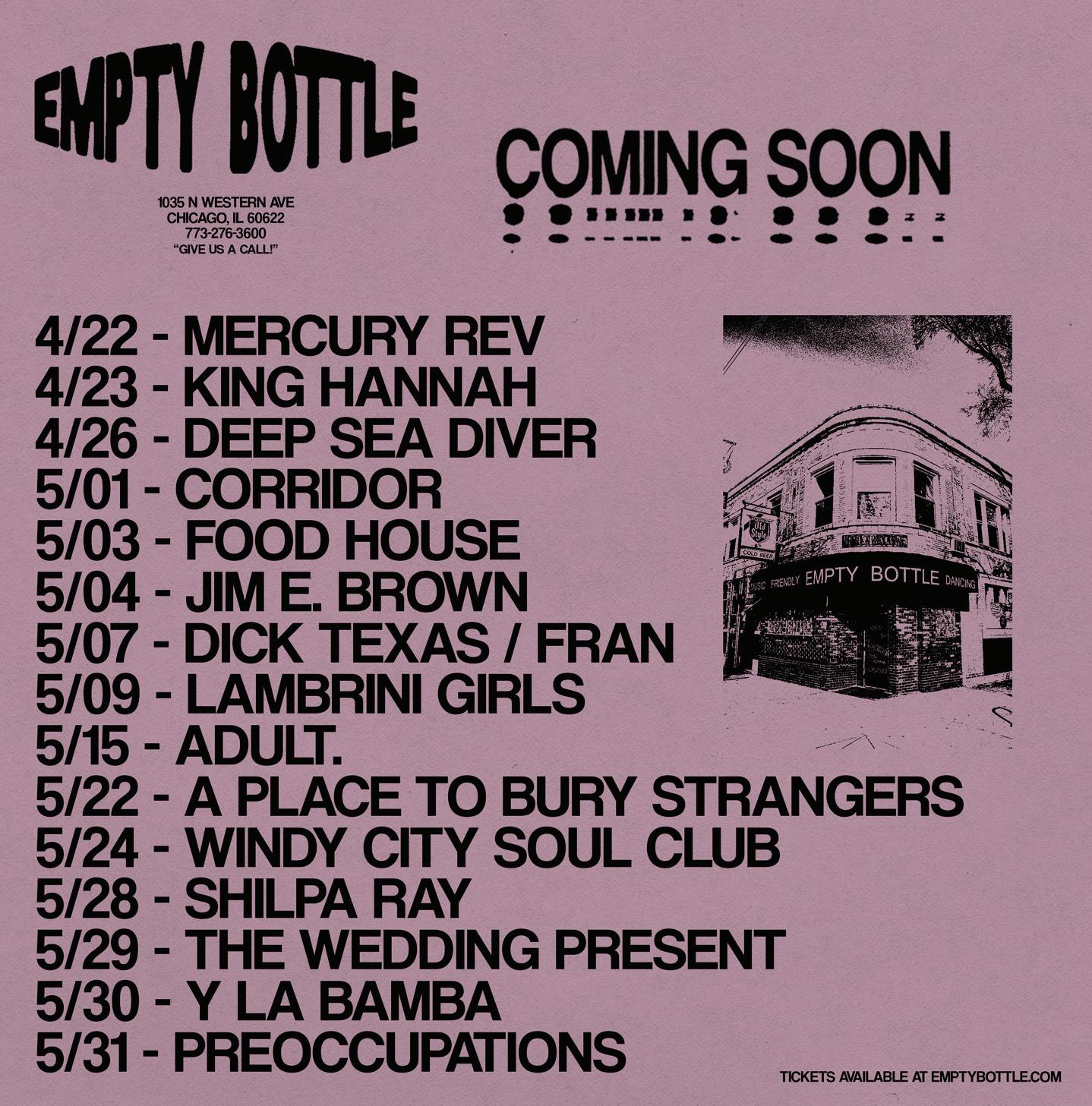
Recommended and notable shows with critics’ insights for the week of April 10
PICK OF THE WEEK
Self-described gunk-pop trio Black Ends revitalize alt-rock with Psychotic Spew
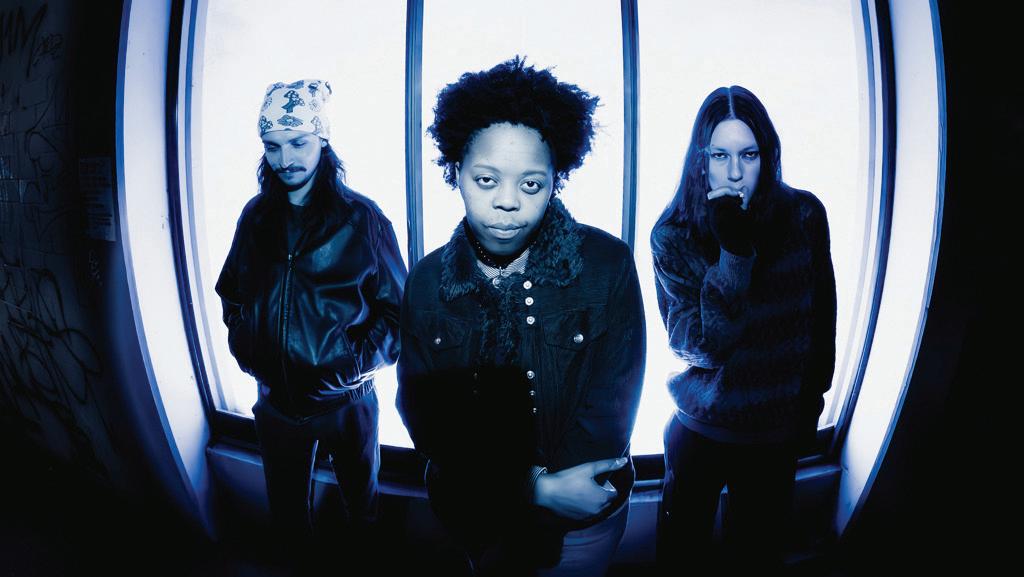
BLACK ENDS, BUM RUSH, DAUNDRY
Mon 4/14, 8 PM, Schubas, 3159 N. Southport, $15. 18+
BLACK ENDS ARE A SEATTLE PUNK TRIO of vocalist-guitarist Nicolle Swims, bassist Ben Swanson, and drummer Billie Jessica Paine. In order to describe their idiosyncratic combination of scru y bubblegum hooks, raw guitar wizardry, and unapologetic indie-rock weirdness, they coined the term “gunk pop,” which inclines plenty of folks (whether the band like it or not) to see them as heirs to the city’s famous indie-rock legacy, from the grunge days onward. Whatever they call themselves, though, Black Ends have carved out their own space in Seattle. In a 2024 profi le for regional music site Wash Magazine, Rob Moura wrote, “The band manages, somehow, to bridge the gap between the oldheads who secretly pine for the city’s days of yore and the youths who—apart from the typical surface sentiment and simulacra—reject those days out of hand. They want something to call their own.” For an artist on the rise, that’s a pretty great place to be. After releasing two EPs, a live album, some demos, and several singles, Black Ends dropped their debut full-length in October. Psy-
chotic Stew (Youth Riot) showcases the band’s e ervescent energy and bright-eyed, only slightly jaded vision by throwing all sorts of sounds at the wall and not even waiting to see what sticks: alt-rock, punk, proggy psych, noise pop, and more. They open the record with the one-two punch of alt-pop banger “She Speaks of Love” and gloriously discordant slacker-rock anthem “Bent.” Black Ends skew moodier on “Pour Me” and “Pretend 2 Be (Protect Me),” with Swims’s controlled, luscious vocals slinking around guitar frizz and fuzz. “Red Worry” feels made for mosh pits, with Paine returning to her fi rst instrument to deliver a blistering guitar solo—and it also features a guest appearance from cellist Lori Goldston, a former member of Earth who’s probably best known for joining Nirvana on their famous MTV Unplugged set. Goldston appears on two other tracks, “Suppin’ on Strange” and “Bye-Bye!,” a psychedelic adventure that defi es its title—it feels less like a farewell and more like a teaser for Black Ends’ next chapter. —JAMIE LUDWIG
Josephine Foster Moon Bros. opens. 8:30 PM, Constellation, 3111 N. Western, $20. 18+
It’s always a special occasion when Josephine Foster rolls through town. The elastic-voiced troubadour was born in Colorado and lived in the Windy City for a spell in the aughts, when she started austere acid-folk duo Born Heller (with bassist Jason Ajemian) and shambly folk-pop project the Children’s Hour (with guitarist Andy Bar). Last year, the Children’s Hour unearthed their long-lost second album, Going Home (recorded in 2003 with Dave Pajo of Slint adding bass and drums), and played their first shows in decades in support of its belated release on Drag City. Since her days in Chicago, Foster has continued to explore diverse musical forms, including traditional Spanish folk (Josephine Foster & the Victor Herrero Band), twangy psychedelic rock (Josephine Foster & the Supposed), and outsider Americana (the Cherry Blossoms, with whom she released Stars of Tennessee last year). At this Constellation concert, Foster will share yet another musical flavor. She’ll be joined by fellow bohemian bard Fred Schneider (formerly known as Matthew Schneider) for a performance focusing on their 2020 collaborative album No Harm Done (Schneider also opens the show as Moon Bros.) That record collects eight sparse tunes infused with country blues, which follow characters grappling with broken relationships and heartache. Foster’s elegiac, lonesome voice nestles into Schneider’s gorgeous swaths of pedal steel guitar as though it’s finally found its perfect musical home (surely, a creaky log cabin with a fireplace). It’ll be a treat to revisit this duo’s harmonious sepia-tone landscape, which shows off Foster’s woozy, sublime songwriting, uncaged old-timey warble, and precisely enunciated operatic singing. That said, the last time I saw Foster live, she sang uncomplicated melodies to danceable backing tracks, so don’t be surprised if she also surprises you. —STEVE KRAKOW
More Eaze & Claire Rousay 8 PM, International Museum of Surgical Science, 1524 N. Lake Shore, sold out. b
Experimental musicians Mari Maurice and Claire Rousay are now based in Brooklyn and Los Angeles, respectively, and they both have extensive discographies of their own. But when they began releasing collaborative records in 2020, they lived in Texas. They became best friends in San Antonio, when Rousay was playing noise rock and Maurice (aka More Eaze) was playing country, and on their new album, No Floor (Thrill Jockey), they’ve named all five tracks a er bars with important roles in their shared history—and the title “Limelight, Illegally” gives you some idea how far back that history goes. The pastoral instrumental pieces on No Floor depart from the duo’s earlier collaborations, which attempt to import the supersaturated sonics of emo rap and hyperpop into an avant-garde space. Their first album together, If I Don’t Let Myself Be Happy Now Then When? (which celebrates the bond they formed by helping each other through transition), piles Auto-Tuned vocals and glitchy, pneumatic synths atop collages of manipulated field record-

ings, pillowy drones, and fingerpicked guitar. On 2022’s Never Stop Texting Me, Maurice and Rousay process rambunctious, maudlin pop tunes to within an inch of their lives, using vocal sounds that feel bolded, italicized, and underlined.
But when the two of them began work on No Floor in 2023, they decided to leave their comfort zone. “We made a very conscious decision to shy
away from using a lot of field recordings and limit ourselves in terms of making songs,” Maurice told Post-Trash in a March 2025 interview. “We were like, ‘No vocals and no field recordings.’”
The found sounds in the duo’s previous collaborations range widely—Rousay scratching a Frisbee, her dog eating right next to a mike—but on No Floor the only such recording I can hear seems to be the chatter of patrons leaving a bar. The album relies much more heavily on conventional instruments: Rousay plays piano and acoustic guitar, while Maurice plays acoustic guitar, pedal steel, and violin. (Both also contribute electronics.) The compositions have an unraveled sort of looseness that comes in part from chance elements—in “Hopfields,” a self-generating modular synth patch just does its own thing in the background—but they also feel patient and serene.
On “Limelight, Illegally,” sighs of pedal steel and languid swells of violin keep getting stepped on by noise—cavernous booms, blurts of twinkling sine tones—but the mood nonetheless remains ruminative. “Lowcountry” uses radiant piano notes to intermittently illuminate a slowly revolving string drone and crumpled interjections of static, which give way to a walking rhythm on plucked guitar and then to melodramatic violin that surges and fades as though you’re walking through a party and overhearing one word from each of a dozen different conversations. Without vocals, No Floor can’t easily express the good humor and playful vulnerability of Maurice and Rousay’s previous collaborations, but it com-
pensates in other ways: The willingness to depart from abstraction, to allow sentiment, sends its own message given that so much ambient music is the audio equivalent of a color-field painting in a corporate lobby. The album is cozy and accessible, and despite its slow metabolism, it’s animated by constant development, with no repetition or stasis. No Floor has the energy of two old friends who’ll never run out of things to say to each other.
—PHILIP MONTORO
FRIDAY11
In 2023, Chicago



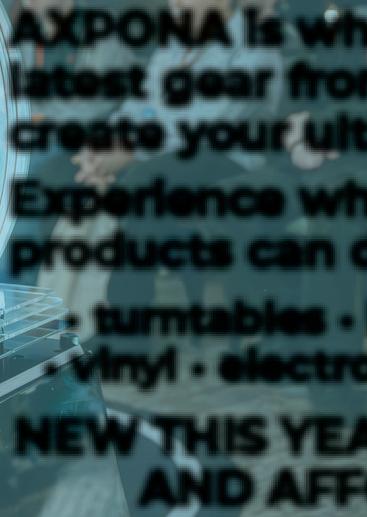

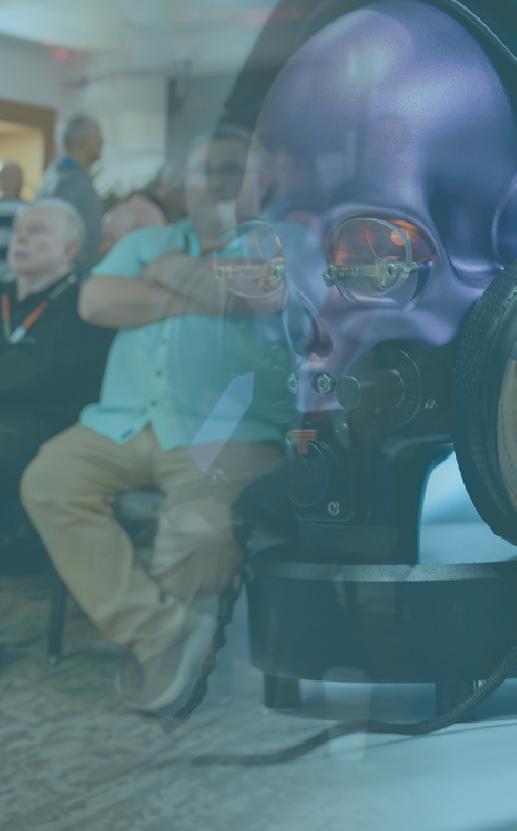



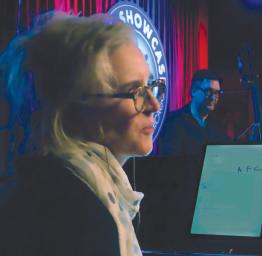
Madame Reaper’s Gentlemen’s Club creates a mysterious fictional backstory about a murderous stripclub owner, and its atmospheric, seductive music draws on 40 years of postpunk and synth pop. Leadholm’s clear, radiant voice and imaginative personashi ing evoke the likes of Kate Bush, Annie Lennox, Siouxsie Sioux, and sometimes Lady Gaga—if Gaga had remained accessible to regular folks at the

club. Leadholm and her collaborator and partner, guitarist Kevin Sheppard, write catchy, infectious melodies, and with an extra push from Leadholm’s poignant lyrics, they sink their hooks deep in your heart.
Madame Reaper’s brand-new second album is called This Is an Album Because the Industry Says It’s Not . Whatever the industry has to say, it feels like a cohesive record to me. “Satanic Tango” flirts with flamenco, and its playful sounds and spicy themes remind me a little of Ann Magnuson’s 1995 cabaret classic “Sex With the Devil.” “Feast” tackles street harassment with an icy, deceptively cheerfulsounding veneer atop a current of simmering rage, while “Falling Apart Again (It’s)” and “Gluing Myself Back Together (Not)” address trauma in haunting laments that could play alongside Julee Cruise tracks on an episode of Twin Peaks . Leadholm’s strong songwriting threads the needle between personal pain and a world that makes hurt inevitable and healing difficult, on a political scale as well
Find more music listings at chicagoreader.com/musicreviews
as an individual one. “Utopia (The Industry)” is an impish-sounding cry for clarity in a climate designed to obscure truth, with a spirit similar to Leadholm’s sentiments in an Atwood Magazine guest column for Women’s History Month: “Be f*ing angry, and then channel it into doing something productive. No one is coming to save us; we have to save ourselves.” From the wrong mouth, that could come off as an empty platitude, but Madame Reaper has a great skill set to be a cheerleader for resistance: She’s unapologetically upbeat but under no illusions. —MONICA
KENDRICK
Sons of Ra Wave Cage and Puke in the Icetray open. 8 PM, Reggies Music Joint, 2105 S. State, $15. 21+
Just a year has passed since Sons of Ra released the six-part instrumental suite Tropic of Cancer, but the long-running local trio have already returned with a new full-length, Standard Deviation Sons of Ra impose few limitations on their music: They might try on any number of heavy and intense sounds, including prog, math rock, avant-garde metal, funk, and free jazz, depending on where the mood takes them. Even so, when it came time to write Standard Deviation, guitarist Erik Oldman Vecchione, bassist and saxophonist Keith Wakefield, and drummer Michael Rataj wanted a new approach. They decided to step away from overt metal influences and lean into collaborative songwriting, drawing on their journey as a band and the diverse personal interests and curiosities they’ve developed over the years. Standard Deviation mixes original compositions with interpretations of tunes made famous by the likes of John Coltrane, Don Ellis, and Carla Bley, and if there’s a dull moment, I must have missed it. “Disintegration (Alabama Revisited)” sets the stage, with layers of horns and guitar and propulsive rhythms that journey through wistfulness, fury, and joy. The band’s take on Ellis’s swinging 1966 piece “Upstart” (written in 11/8 time) could soundtrack an outer-space film noir: A 1940s private eye flits off into the cosmos (accompanied by a guest solo from flutist Isaiah Sanderman) to unravel an intrigue that builds to a jaw-dropping intergalactic shootout (punctuated by Rataj’s fiery drumming). Sons of Ra take a more traditional approach to “Nature Boy,” taking Coltrane’s version as a starting point and creating a lush reading that ends with joyous sax and ferociously metallic guitar. They also revisit some of their own material, offering a triumphant reworking of “Intrepidation,” which originally appeared on 2016’s Anthropology . This show is a release party for Standard Deviation —JAMIE LUDWIG

Black Ends See Pick of the Week on page 24. Bum Rush and Daundry open. 8 PM, Schubas, 3159 N. Southport, $15. 18+ v
Administrative Manager: Norridge IL. Coord admin activities of optometrist office. Investigate & resolve complaints. Perform clerical & admin functions. Prep docs for accountant. Patient education reg lenses, eyeglasses. Update patients’ charts. Oversea sales. HS 24 months exp in any business admin position. Res: MBMJ, Inc. mbarsky15@yahoo.com
Assistant Professor
Loyola University Chicago is seeking an Assistant Professor in Chicago, IL to teach undergraduates courses in the area of Biochemistry. Full time. $75,000 - $90,000/ yr. Competitive compensation (please see https://www.luc. edu/hr/benefits/). Please send res to mballic@luc.edu & ref job 050286.
Associate Attorney. Research case law, court decisions, documents, opinions, briefs, and/or other legal information related to cases, interpret law and draft legal documents. Multiple Openings. Employer: Huang & Hu PC. Location: Chicago, IL. To apply please mail resume to Y. Hu at 77 W Washington St., Suite 800, Chicago, IL 60602.
Computer Programmer sought by INFI USA INC. to ensure quality and reliability of software. Req. Bachelor’s in CS, IT, or related; plus 1 yr experience in software testing. Salary: $65,520/ yr. Worksite: Chicago, IL. Send resume: 159 N Sangamon St, Suite 200, Chicago, IL 60607. Send resume: 159 N Sangamon St, Suite 200, Chicago, IL 60607
CTC Trading Group, LLC seek Quantitative Traders in Chicago, IL to build on previous research and trading experience to drive the profitability of a highly electronic trading operation. Telecommuting is permitted. Wage Rage: $150,000-$250,000. Apply at https://www. jobpostingtoday. com/ Ref #94458.
CTC Trading Group, LLC seeks an Engineer in Chicago, IL to build and maintain highly scalable data pipelines across our on-prem and cloud platforms. Telecommuting Permitted. Wage Rage: $125,000-$225,000. Apply at https://www. jobpostingtoday. com/ Ref #52939.
Dynamic Motion Control (Chicago, IL) seeks Senior Project Engineer to provide expert level competency at isolating system problems & directing teams to solve them for all DMC customers. Must be certified LabVIEW Developer or Architect. Must have at least 3.4 GPA at time of degree completion. Must take & pass pre-hire DMC coding test. Travel req. w/in the U.S to client sites 30% of the time. Remote work option w/in the U.S. w/ req. travel to company’s local office 40% of the time. Salary: $150,862/ yr. Apply at dmcinfo. com/careers, Job ID: 95
Health Care Service Corporation seeks Sr Systems Analyst (Chicago, IL) to be responsible for design enhancements & new business applications & information systems solutions through integration of technical & business reqs. REQS: Bach & 4 yrs exp. Telecommuting permitted 2 days/week. Pay: $127,754 - $164,200/yr. Benefits: https://careers. hcsc.com/totalrewards. Email resume to hrci app@ bcbsil.com, ref R0040873
HR Specialist: Elk Grove Village IL. Recruit individuals. Sourcing & interviewing candidates; HR procedures; maintain employee records; select job applicants, maintain & update HR documents: org charts, employee handbooks, directories, perf evaluation forms; conduct exit interviews; develop or implement recruiting strategies to meet current or anticipated staffing needs; conduct reference, background checks; writing website & social media content relating to current openings; manage employee relations. 2 yrs exp & bachelor’s degree in business admin or closely related field. Res: Lantech Communications LLC; management@ lantechcable.com
KOO LLC (Chicago, IL) seeks Architectural Designer to assist in designing/detailing & documenting/preparing technical specifications & providing construction admin. services for buildings & spaces. Must submit electronic version of portfolio w/ examples of academic projects & professional work incl. the role on the project/digital images/ photographs & examples of technical drawings of commercial buildings/ civic/multi-family & custom hospitality project typologies. Portfolio must also demonstrate samples of work in Revit & graphic & digital presentation software programs.
Remote work option 20% of the time w/manager approval unless req. to attend project meetings. Occ. travel req. to local client sites at least 1-2 times/month depending on phase of project. Salary: $76,482 /yr. Submit resumes to employment@ kooarchitecture. com, ref. Job ID: 251001 in the sbj. line.
Nutrition & Cost Specialist: Mount Prospect IL. Assess clients’ nutritional & health needs by following medical studies. Counsel mgnt on nutrition & healthy eating habits. Develop meals & recipes for catering of specialty food store. Monitor purchasing of healthy food prod for catering. Estimate cost. Monitor catering of Polish cuisine prep acc to trad recipes: pierogi, golabki, kluski, rosol, bigos, barszcz. Order food, supplies. Control costs. Monitor inventory. Nutrition or Dietary Technical High School or foreign equivalent.
$45,261 per year.
Benefits. Res: Krystyna’s Deli, Inc dba KD Market office@mykdmarket.com
Senior Analyst, Business Systems (Pharmaceutical Industry Packaging & Manufacturing), AbbVie Inc., North Chicago, Illinois. Building SAP & POMs master data recipes. Generate & analyze SAP data for transactional function ability, while also assisting in the development of standards & procedures. Utilize experience in Systems Testing & IT Implementation. Utilize experience in solution design in SAP (Production Planning, Quality management, Plant maintenance). Utilize knowledge of SAP integration with other systems (Tibco, MES systems, Antares). Must have a Bachelor’s degree in engineering or computer science or related, & 5 years of work experience in engineering, &/or business systems analysis. Of work experience required, must have 5 years in each of the following: (i) performing Systems Testing & IT Implementations; (ii) developing solution designs in SAP (Production Planning, Quality management, Plant maintenance); (iii) overseeing the SAP integration with other systems, including Tibco, MES systems; (iv) performing SAP methodology (applications, integrations, change management, & training); & (v) applying Business Processes, accounting principles, systems configuration, enhancements, & master data elements.
Alternatively, would accept a Master’s degree engineering, computer science or related, & 4 years of work experience in engineering, &/or business systems analysis. Of work experience required, must have 4 years of (i) through (v). Work experience may be gained concurrently. Employer would accept any suitable combination or education & work experience. Apply online at https:// careers.abbvie.com/en & reference REF37817U. Salary Range: $126,755 - $153,000 per year.
Federal Home Loan Bank Chicago is seeking a Senior Risk Analyst in Chicago, IL. Review and evaluate models used across different groups, including pricing models, credit risk models, market risk models, analyze model inputs, assumptions, methodologies, and results to assess model soundness and to identify potential weaknesses, biases, and limitations, recommending enhancements and modifications. Must live within normal commuting distance of worksite. Up to 40% remote work allowed (require 3 days on site per work week). Apply on-line at fhlbc.com/careers
Solution Architect Chicago, IL Amdocs, Inc; Support s/ware production & s/ ware solution review w/ multiparty s/ware platforms. Dsgn, devel, analyze, & debug s/ ware solutions accord to funct’l & tech design specs for app for wireless telecomm industry. Assist devel teams by providing solutions for QA Testing & User Acceptance Testing defects. Reqs knowl of web & programming methodologies (i.e., Oracle Database, SQL Server, Teradata, MySQL, PLSQL, Unix Shell Scripting, Oracle Business Intelligence); & Cloud techs (i.e., Azure Data Factory (ADF), Azure SQ, AWS Cloud Technologies, Azure Cloud Cosmos DB; Power BI; SSIS/SSRS, Informatica PowerCenter & Power Exchange). Reqs Bachelor’s (or frgn equivt) in Comp Sci, Comp Engng, or closely rel s/ware or engng degree + 60 mo’s exp as an IT prof’l. Sal: 148949/yr. Co Benefits: 401(k), Hybrid Work, Health Ins & Unlimited Vaca. Apply https://jobs. amdocs.com/careers/ job/563431000666107 Req ID - 195214
Tempus AI seeks a Senior Software Engineer in Chicago, IL, to build next-generation healthcare platforms and tools using modern software technologies. Telecommuting is permitted. Wage range $105,310.00 - 167,000.00. Apply at https://www. jobpostingtoday. com/ Ref #11219.

3BR 2BTH 6337
S Drexel Ave
Short distance to the Museum of Science and Industry. 1.9miles to Jackson Park Golf Course & 3.5 miles to South Shore Golf Course.This has a master suite that features a attached bathroom with jetted bathtub. Email: Drexel8000@gmail.com
CHESTNUT
ORGANIZING AND CLEANING SERVICES: especially for people who need an organizing service because of depression, elderly, physical or mental challenges or other causes for your home’s clutter, disorganization, dysfunction, etc. We can organize for the downsizing of your current possessions to more easily move into a smaller home. With your help, we can help to organize your move. We can organize and clean for the deceased in lieu of having the bereaved needing to do the preparation to sell or rent the deceased’s home. We are absolutely not judgmental; we’ve seen and done “worse” than your job assignment. With your help, can we please help you? Chestnut Cleaning Service: 312-332-5575. www.ChestnutCleaning. com www. ChestnutCleaning.com
Cello lessons in the Fine Arts Building. All ages, beginner to early advanced Free intro consultation. Saturdays. heatherdunncello.com
Classical Acoustic Guitar Lessons offered at my residence. Old Town area, just a few blocks away from the Clark and Division Red line train station. Call to discuss. All Ages and Levels welcomed. 773-234-7311

